










Advertising Sales
Danielle Brown danielle@topsouthmedia.co.nz
Summa Donald summa@nmf.co.nz
Steve Page steve@nmf.co.nz Accounts
accounts@topsouthmedia.co.nz












Advertising Sales
Danielle Brown danielle@topsouthmedia.co.nz
Summa Donald summa@nmf.co.nz
Steve Page steve@nmf.co.nz Accounts
accounts@topsouthmedia.co.nz

Cyclone Gabriel’s damage across large areas of the North Island is unbelievably sad. Isolated by road and infrastructure damage and most importantly communication many face a very uncertain future.
We all sympathise at the deep personal cost and want to help but it’s not just down the road and most farming people are flat out already. Recent floods in our own regions have given us a taste of what it’s like to be hit with a weather bomb and endured the cost.
There are different lessons to be taken from every weather event and in different areas. It’s down to us in the rural sector to make our own contingency plans wisely.
Communication is a big one, owning a generator and keep-
Our thoughts are with farmers, growers and families impacted by Cyclone Gabrielle across parts of Te Ika-a-Māui, the North Island. This has been a damaging event and we know it’s an extremely difficult time. It’s also going to be a while until the full scale of the devastation is known and the recovery phase will be long.
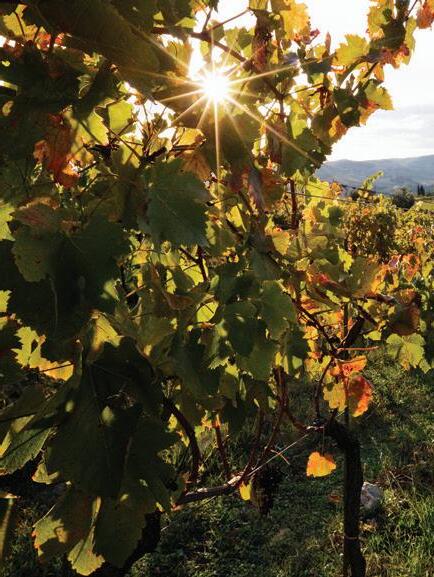
If you are wanting to support those affected in the form of donations then officials are saying the best way to help is through cash donations as opposed to donated goods.
NEMA Director Roger Ball said donated goods can create a “significant overhead” and may not be well-matched to the needs of those on the ground.
“Truckloads of donated stuff, which is well intentioned, but... cash donations to the relief
ing more than a week’s supply of everything we need on a farm makes sense. 2023 has only just begun and it’s shaping up to be difficult. I can only speculate on the cost to the entire country from lost production in the Hawkes Bay, Napier and Hastings area so close to harvests. Plus, add in Northland and its obvious jobs will be lost and prices of fruit and vegetables will increase, hitting urban Auckland.
The whole of our country will take a huge hit. The economic future looks grim for many on farms balancing
income against outgoing costs. All we can do is keep on doing our best and counting our remaining blessings.
We hear stories of depression in the rural community and now its hit urban towns too.
Over the next year many will need to dig deep and re-think their future. I could say a lot more about leaders on an international scale not valuing food production and food security but that’s another topic.
From personal experience, it’s at these times we find keeping going is heaps better than giving in to depression. We do
this by noticing beauty around us, exercising and hanging out with people who lift our spirits. It’s the small things hugging a child, visiting a friend and deeds of service that truly help. Whoever you are wherever you are there a people who will listen when the going gets tough. If there are hard decisions to be made seek our professional advice.
Making decisions can be difficult but freeing once made. Keep in touch with friends and neighbours, especially those badly affected and don’t forget to have a good laugh about something silly as often as possible.
Host another farmer for a mini break over the coming months and keep your emotional tank as full as you can. We at the Top of the South Farming value our rural people and love reporting your stories.

funds are best,” he said. In most cases, donated goods with the absolute best intentions end up more of a hindrance than a help. Roads are impassable in many areas and more importantly, teams on the ground just don’t have the facilities, time, or people to sort through donations.
are:
• Visit your local Farmlands store and donate through your Farmlands Account to the 2023 Cyclone Gabrielle Relief Fund. 100% of your gift will be used to help support the livelihoods of farmers and growers hardest hit by the disaster

• Rural Support Trust National Office, has set up a relief fund for farmers and growers you can donate by going onto ‘givealittle. co.nz’ and typing in Rural Support Trust or off rural-support. org.nz
• There are also multiple options on ‘giveattle.co.nz’ to donate directly to certain farmers.

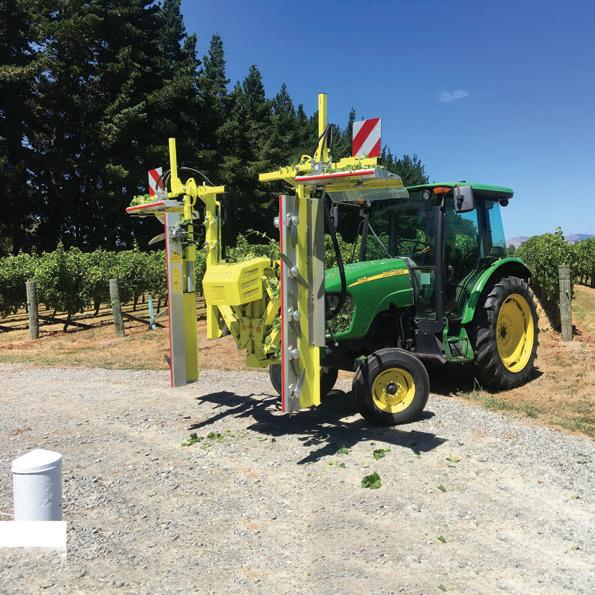
Cyclone Gabrielle has proved to be every bit as bad as forecasters warned, if not worse. Coming on top of the destruction wreaked by Cyclone Hale, and a very wet season in many parts of the country (though certainly not the deep south), the damage caused is going to prove extremely costly.
Fixing roads and other infrastructure in some regions will take months, even years, and we will be advocating to government that additional resources to get that work done should be top of their agenda.
Firstly, I want to acknowledge all those who continue to work tirelessly to help our communities through this event: the people in lines companies, emergency services, emergency management and roading contractors, to name a few.
Many of them have been out in appalling conditions, and their efforts to help out in many cases have been nothing short of heroic.
The event has had a significant impact across much of the North Island, with particularly severe impacts from flooding, high winds and slips in Northland, Coromandel, Gisborne and Hawke’s Bay.
The immediate focus of Federated Farmers is on making sure Emergency Management are aware of issues and ensuring people are safe. The priorities have to be people, power, communications and access. We’ve also been in contact with the New Zealand Banking Association, Inland Revenue and other agencies to ask them to explore postponement of hard
deadlines and other ways to help lessen immediate financial impacts.

Some farms and communities are completely cut off or have very limited access.
Helicopters, including from Defence NZ, are up in the air in several districts today helping with assessment of damage and to reach places where roads are impassable.
There are large areas without power, landlines or cell coverage. It has been indicated that some of these areas in Gisborne and Hawke’s Bay may not have power restored for days, if not longer.
We have requested that the government communicate key messaging via Radio New Zealand and other radio station networks, because without cell or internet this may be the only practicable way to reach some farms and communities.
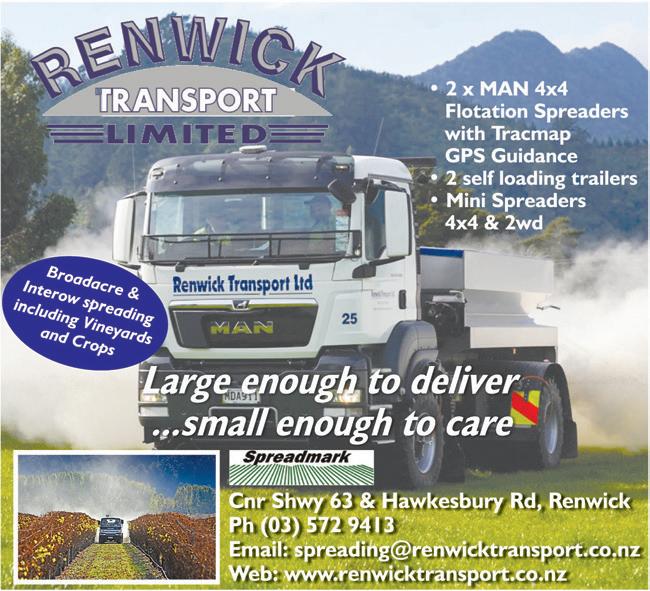
The effects of the cyclone will last for weeks, months, and in some cases years.
We are very aware that due to the flooding and ruination of hundreds of hectares of maize crops, stock feed is likely to be an issue.
Farmers and their families hit hard may look out on the dam-
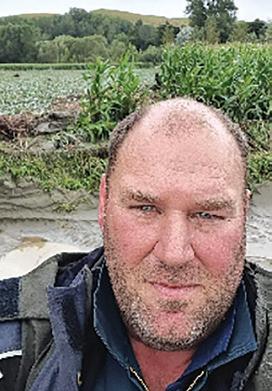
age and feel overwhelmed. Mental well-being is a real concern. Our message to these farmers is ‘you are not alone, reach out and talk to someone…a problem shared is a problem halved’.
Your Rural Support Trust is there to help. For those feeling stressed and a sense of hopelessness, when you get a chance (and electricity restoration allows!) take a look at the resources on Farmstrong and the new initiative outlined in last week’s Friday Flash, First Steps.
Recovery for some is going to be a long haul, and your key priority is your own health and that of your family and farm team.
Currently, we are constantly assessing what our farmers need assistance with and are working to make sure the information gets to the right people to respond. We are in contact with government agencies to ensure farmers have a voice. Federated Farmers has been approached by those wanting to assist either by volunteering their help or offering a donation – links to register help and donate are on the website homepage.
We also acknowledge that in the Otago and Southland regions many of our farmers are experiencing very dry conditions that are challenging to say the least. Unfortunately, unsettled weather is predicted to continue through to April. New Zealand farmers are renowned around the world for their excellence and initiative. We need each other more than ever. Look after yourselves, and check in with your neighbours.
MAUREEN PUGH National List MP
Our hearts go out to all New Zealanders affected by Cyclone Gabrielle, and in particular those who have lost loved ones, their homes and their livelihoods. It’s shocking to see the scale of destruction the cyclone has brought but it is heartening to see how New Zealanders have come together. Our thanks go to emergency responders who have worked tirelessly, and the many people working to try and restore power, communication, and roads. The focus right now remains on finding people who are unaccounted for, re-establishing power, water, communications, fuel and supplies, and finding accommodation for families who have lost their homes. The economic impact of the cyclone is going to be significant. Many businesses were already struggling post-covid, with rising costs and workforce shortages. The cyclone has destroyed many fruit and vegetable businesses, and for those growers it is going to be a challenging road back. Not only are their crops decimated, but removing the silt and replanting is going to be huge task. One of the first thing the government must do it come up with a targeted wage support. These businesses need immediate support to keep themselves afloat and retain staff. The government should also consider changing our immigration settings to help with the clean-up and fast track the rebuild. It will require a range of skills to help with infrastructure repairs and building new homes, and farm sheds.
The building and construction sector is already short of tens of thousands of workers, and we need will require a range of skills to help

with fixing houses, farms, sheds, roads, powerlines. I also hope that banks will show compassion to those in difficulty. It is in situations like these where we see the best of New Zealanders. We have seen some tremendous generosity from people right around the country. One South Island initiative, which I featured on my facebook page, involved local companies donating farming equipment. Ensuring fences and yards can be replaced or repaired and feed for stock is available, is although only a small gesture, could help ease the stress for some farmers. It has become clear that in urban areas cash donations are what will make a difference at the moment because that allows the relief agencies on the ground to buy what is urgently needed, and distribute it to those they need it most. Longer term, it is clear we need to ensure our infrastructure is able to handle extreme weather events. I have a Private Members Bill that focusses on preventative maintenance, which local councils don’t always get done. My bill seeks to allow access to rivers, drains, culverts and under bridges where gravel and other rubbish builds up which can cause flooding, I hope this practical piece of legislation gets widespread support in parliament.
Cyclone Gabrielle has once again raised huge questions about the damage done by forestry ‘slash’ to infrastructure. Clearly harvesting practices have to change and National supports an independent review around forestry. Cyclone Gabrielle is the one of biggest, if not the biggest natural disasters to hit New Zealand. It’s effects will be for many years to come. Regions affected will not be left behind. National will do what it takes to ensure these regions recover and rebuild
Let’s all rally around those affected by the cyclone

One of Australia’s largest agribusinesses has brought into PGG Wrightson. Elders purchased a strategic 11.3 per cent stake which was obtained via private sale at $4.35 a share for a total $37.1 million.
Elders have said the purchase will be funded by debt and that the move to purchase is in line with its “geographic diversification strategy”. Elders have clearly stated that they do not currently intend to initiate any proposal to acquire control of PGG Wrightson.
In 2022 PGG Wrightson shares traded between $3.90 and $5.76. PGG’s cornerstone shareholder is Chinese controlled Agria with a 50.52 per cent stake. For the year ended September 2022, Elders reported a profit of A$162.9m ($173.2m NZD) a rise of 8.7 per cent. PGG, who have 170 stores nationwide and employ around 1800 people, stated that strong performance from its water and retail business had helped the company achieve a net profit of $24.3 million, year ending June 2022, 7 per cent profit up on the prior year.
FROM PAGE 1
Being a shepherd is what Julie Edwards knows.
She was raised on a romney stud in Havelock.
“Which is where my love of sheep comes from,” she says. It was during her time at Marlborough Girls’ College that she heard about the idea of milking sheep.
“It just really appealed to me, I like genetics and the health benefits seemed great, I wanted to try it,” explains Julie.

The school put her in touch with an Industry Training Organisation (ITO) adviser who managed to find someone in the Neudorf area who was actively milking sheep.
Julie contacted him and it turned out he was looking for a farm hand, so Julie decided to ‘give it a go’ and moved to the Neudorf farm.
Time flies by and soon enough Julie and husband
Nathan were leasing the farm with their own stock on it and milking the sheep themselves.
“You milk a sheep the same way you milk a cow only you have two cups not four and the cups are much smaller.” Sheep will produce one-
three litres of milk per day, although this will increase in time with the improvement in genetics and age of the ewes.
Still this amount is less than a goat and much less than a cow produces.
“It was really hard work as we were doing it on our own, I didn’t have a day off for three years,” she says.
“We learnt so much though”. Things changed for the couple when they purchased their own 50 acre block in the Moutere, which has sheep and woodlot trees on it, however they both now have off-property jobs.
“Even though I wasn’t milking sheep anymore my love for them continued, so I was thrilled to get a job shepherding which is what I have done my whole life.” She’s also lucky to have a job close to home.
“I know some people travel long distances to their work, mine’s just down the road which is awesome.”
Julie says that she knows others in the industry who face long, isolated days which can be challenging.
“I’m really fortunate as I work a bit on my own but have other people around and someone is always coming or going from the
farm so I get to chat with others often.”
Recently Julie has been kept busy with stock shifts, weed control and pasture renewal.

“It’s a busy job but I love the day-to-day variety, I’m hugely passionate about working with my dogs so
chatting and the rest is history,” she laughs.
“I really enjoy the dog trials, there is always something to learn.”
Julie calls herself an active relaxer.
“I like to spend my spare time horse riding, training pups for work and trials as well as working with my hubby around our property,” she says.
“Nathan and I really love the bird song here and the stunning sunsets.”
Julie encourages anyone who is interested in getting into farming or ag work to give it a go.

it’s great my work involves them.”
Julie has five dogs that go to work with her each day.
“They all do different jobs and work well together.”
Julie’s passion for working dogs has inspired her to become involved in the Tapawera Dog Trial Club.
“Years ago, at a beef and lamb field day, I met a guy called Rodney Biggs who was from Wakefield, he was into dog trials and we got
“Contact ITO or look up New Zealand Farming on Facebook, there are heaps of people out there willing to help you get into the industry even if you have no experience,” she explains.

Julie is also offering an open invitation to anyone who is interested in dog trials. “Come and see what we do, it’s family-friendly and fun, just swing past and have a look.”
Tapawera Dog Trial Club: 4627 Motueka Valley Highway, Tapawera. Friday the 24th March 1pm-5pm and Saturday 25th March 8am4pm. “Go on - give it a go!” she says.
I know some people travel long distances to their work, mine’s just down the road which is awesome.
Julie Edwards

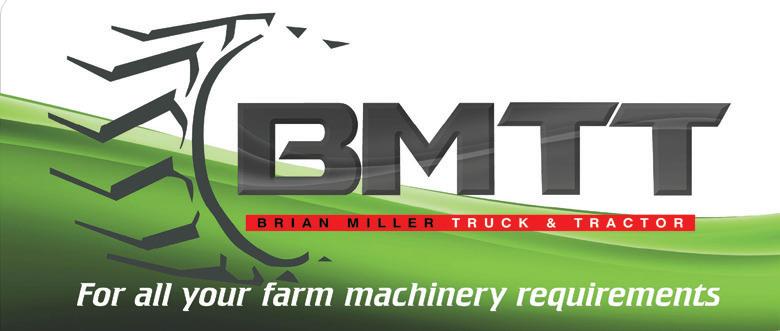

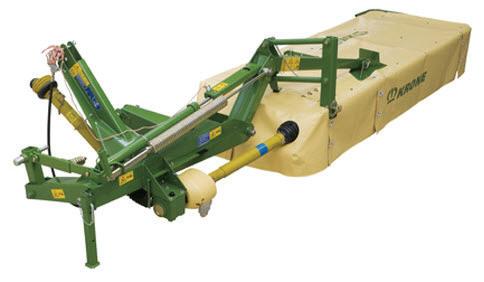









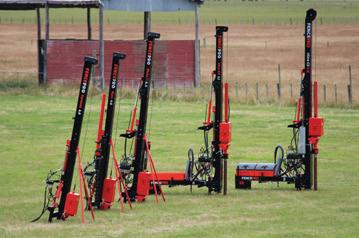
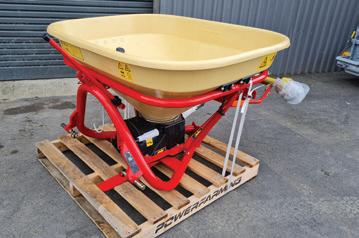
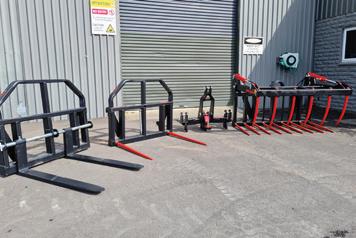

Tapawera was buzzing with shearers from across the Top of the South and from as far as Kaikōura and Canterbury for the annual Sports Shears competition.

The competition, held on Saturday, 28 January, drew a big crowd with the annual music in the mountains event being held at the same venue.
With 702 caravans on site and upwards of 2000 people. the campers were well entertained. In the morning the day started with the junior shearers going through the grades with the open class after lunch.
It’s safe to say there was great entertainment for the onlookers with competitors also enjoying their day.
It was nice to have people from the crowd acknowledge the skill that the shearers have, with a number talking of their roots to the land and farming background -clearly bringing back fond memories.
Tapawera Shears organiser, Kerry Irvine, says much thanks needs to be given to the people behind the scenes.
“From the farmer Pamela Irvine
of Mt Jones farm supplying 330 beautiful hill country perendale ewes, the crutching team that prepared the sheep days beforehand and the team who make the event run on the day.
“Many thanks to David & Lynn Baigent, Sheryl Win, and the competition judges on the day. Baden and Hamish Barker for the work they do behind the scenes and on the day, and to the many people volunteering their time to
make this event happen.
“Last of all I need to acknowledge our fantastic sponsors. We have great support from our sponsors, and I thank them very much. Without them we don’t have a show.
“It was a great day, cheers to you all,” Kerry says.
Former Southland shearer Floyd Haare successfully defended the open shearing title.
Floyd, 35, now based at Bainham, near Collingwood, dominated the four-man final, shearing the 20 sheep in 19min 24.22sec, beating second-man-off and eventual runner-up Nick Nalder, of Tākaka, by more than two sheep,
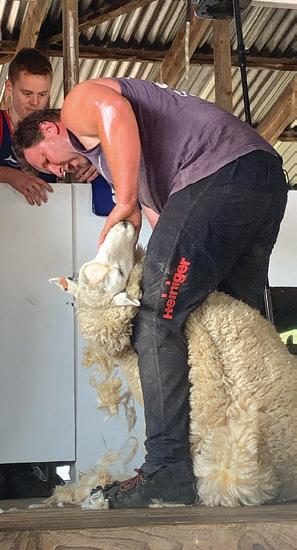
a buffer of almost 9pts on time. There were more than two minutes back to veteran Blenheim competitor Chris Jones, who won the Open Plate at Tapawera last year, and who at the age of almost 65 has competed at all three Top of the South shows so far this season, also finishing third at the Marlborough show in October. There were nine shearers in the open class at Tapawera, among 19 shearers across the four classes, notably Lydia Thomson, who has now shorn in 10 finals this season for seven wins, including two national title wins, at the Corriedales championships in Christchurch and the crossbred lambs championships at Winton.
She was also runner-up in two other national title events, on the longwool of the Waimate Spring Shears and the full wool of the Northern Southland Community Shears near Lumsden. Headed for the Intermediate grade next season, and having recently shorn 200 ewes in a day at work for the first time, Lydia also won a women’s event, and in the Clean Shear was third behind Chris Jones and Senior final winner Timo Hicks, of Tapawera. The Intermediate final was won by Dylan Hamlin of Bainham. Despite the smaller number of entries, Lyn Baigent, who does the points at all the shows in the region, said it was a good day“but hot.”
Handy to town, with bare land, irrigation water available and vineyard potential, this attractive property is nowadays unique. The home presents spacious open plan living, great outdoor flow and spectacular views. A den could be a third bedroom in the main house while a separate annex offers comfy twobedroom accommodation for family, friends and additional income from paying guests. Professionally designed and maturing beautifully, the gardens are aesthetically pleasing and impressively productive.
28 Tyntesfield Road, Waihopai Valley, Marlborough nzsothebysrealty.com/CCR10459

DEADLINE SALE: Closes 12:00 p.m. Thursday 13th April 2023 (unless sold prior)
Michal Wells
+64 21 420 428
michal.wells@nzsir.com

Tim Crawford +64 21 704833
tim.crawford@nzsir.com
A recent ‘ladies day out’ hosted on deer farm 4km out of Murchison was a “Great success” says Jude Alfeld, one of the four key organisers. The R18 event was open to all women, not just farmers, and aimed at getting women together for a day to themselves while also raising funds for Nelson Tasman Hospice. “We wanted women to come and enjoy themselves, have a break from the kids and the chores” Jude adds.
Around 100 ladies attended the day and together they raised $3,500 for Nelson Tasman Hospice.

The women enjoyed a shared lunch, a clothing fashion parade and exploring locally made things such as skin care and honey.
This is the second year that the event has been held and the team organising it are confi-
dent there will be a third event next year in February 2024.
“We already have some ideas for next year, we want to continue growing this and I am excited to see what next year brings.” Smiles Jude “It is so uplifting to see all the wom-
en come together and it’s encouraging to have already received many comments from those who enjoyed the day and thought it was wonderful. It was a great day, with great women, a lot of fun and for a good cause.”


A destructive and unwanted plant pest has arrived for the first time ever in the South Island.
The Ministry of Primary Industries are asking people to be on the lookout for it and to report any sightings - have you seen the Fall Armyworm?
The Fall Armyworm is a destructive plant pest that can feed on over 350 plant species, but by far their favourite snacks are maize and sweetcorn crops.
They also enjoy asparagus, beans, peas, brassica, onions, kumara, lettuce, tomatoes, eggplant and capsicum. It is called ‘armyworm’ because, in its larval stage, individuals gather in huge masses (‘armies’), which then destroy large crops.
It is native to America and since 2016 has spread to Africa, Asia and parts of Australia. As a hitchhiker pest that can be blown many hundreds of kilometres on storm fronts, it has been on New Zealand’s Biosecurity radar for some time. Farmers and growers in the upper North Island began reporting larvae finds in September/October last year. Recently there have been three confirmed findings in maize paddocks on the West Coast, which is the first time it has been detected in the South Island. The number of confirmed findings had increased to 56 (as of January 14). It’s arrival has arable and vegetable growers worried.
“The Fall Armyworm really affected crops in China when it ap-
peared there so it’s not good news to see it in the South Island and so close to our region,” says Stephen Todd, president of Nelson Federated Farmers and dairy farmer from the Tutaki Valley in Murchison. In the past four years, the Fall Armyworm has caused extensive economic damage across Africa, South Asia and Southeast Asia. “Many dairy farmers like myself have small maize crops so we need to be on the lookout.”
MPI’s biosecurity response is currently focusing on identifying key areas to understand the geographic spread and scale of the Fall Armyworm incursion. “This is a new pest to us; we need to do everything we can to control it,

starting with reporting any sightings so we can work out exactly where they are,” Stephen says. “Once it turns into a moth it can travel a long way each night so it has the potential to spread at high speed”.
In fact, the insect has the ability to fly more than 100km per night and in a small country like New Zealand it would not take long for it to be nationwide.
While this is a new pest to New Zealand treatment options are available and include several types of insecticides, many of which are already used in New Zealand for other kinds of pests, as well as pheromone traps. “At this stage our main tools of de-
fence are detecting the pest early, spraying at the right time and reporting any findings,” Stephen says.
“If you have this pest, removing crops will not control the Fall Armyworm, but by reporting it you will get good advice on how to manage it.”
Messaging is not just targeted at arable and horticulture growers. All farmers, grower, lifestyle owners and gardeners need to be on the lookout and actively scouting for caterpillars. “Now it’s here we won’t be able to get rid of it, so we need to look at how we can control it and prevent it wreaking havoc on our agriculture sector,” Stephen says. “I’m sure if your
neighbour had it on their property you would want to know. Everyone needs to play their part, report findings and support those who have invasions.”
If you suspect you have the Fall Armyworm on your property or in your garden, please refer to the contact information below. Since this is an unwanted organism all findings must be reported to MPI: https://report.mpi.govt. nz/pest or using the app https:// www.fi ndapest.nz/ , by email to FAW@mpi.govt.nz or by freephone 0800 80 99 66. There are no negative consequences to growers for reporting, as this pest will not be controlled by removing crops.
DairyNZ held an event on February 8 with Mark and Esther Tubman who are contract milkers at Puramahoi in Golden Bay for John and Anne Freeman.
They currently milk 350 cows on the 150-ha platform with heifers reared and cows wintered on support blocks.
For many years the business has focused on low-cost production combined with a low environmental footprint.Mark formerly spent four years working on a high input system reliant on nitrogen, which also had high levels of debt, before working in Golden Bay.



“It makes more sense to have an all-grass system utilising regenerative pastures to help reduce reliance on nitrogen use,” he says. Over the past 12 months following on the
practice of John and Anne, they’ve only used 31kg per hectare of nitrogen.
They’ve also been using a crop of regenerative summer crop mix which includes sun flowers and other species, The summer grass mix was direct drilled in October. This kind of mix is good for the soil and provides summer drought resistance. The idea being that grass species with longer root systems will also help to withstand dry conditions.
John and Anne have been using the biological Kinsey Albrecht fertiliser, and a spring and autumn round of fish fertilisers for the past eight years. Comparing a three-hectare conventional pasture with the three hectares of regenerative pasture, Mark has found they are doing a 30–50-day rotation between grazing on his
summer pasture mix and the overnight feed required is only 1.5 hectares. They’re getting an extra nights feed whilst maintaining and im-
proving production. So far this season they are up 4 per cent. Up 18 per cent in January and so far for February they are up 17 per cent. With the past two summers being wet, he’s been unable to gauge just how beneficial the summer pasture may have been. However, the red clover and other nitrogen-fixing species not only help reduce nitrogen use but will be good for the soil, he believes. Mark commented that giant buttercup, which is a big problem, appears to get shaded out.
Local DairyNZ extension partner Mark Shadwick commented that farmers attending the event seemed to be impressed by the multi species sward that was established three years ago and is currently being grazed on a longer round than the standard ryegrass paddocks.

Kotare Hops has taken out Grower of the Year for the second year in a row.
The award recognises the hard work that goes into producing high-quality hops and overall hop quality across several categories.
The Moleta family are always striving to improve and deliver, proving once again that they have the commitment and passion needed for hop growing. Well done to their team for an outstanding achievement.
Noel Moleta admits he barely gave a thought to the number hop gardens alongside the Tapawera property he’d purchased to farm sheep and beef.
All his working life he’d farmed animals in the isolated reaches of the Pelorus Sounds, at ‘Waitui.’ The family had farmed there since the 1970s, when his father Vince bought ‘Waitui’. Noel has been carrying on the sheep farming tradition his Italian immigrant grandfather Antonino Moleta established on D’Urville Island more than 125 years ago.
The Tapawera farm purchase in 2015 was Noel and his wife Debbie’s plan to spend more time living closer to civilisation.
“All I knew about hop farming
was that the industry had struggled through a downturn for quite a few years,” Noel remembers.
“But then I saw a real estate advertisement for a hop farm up in the Sunshine Valley with an asking price of $10 million, I was amazed. I realised hops were very much in demand again.”
By the time he had introduced himself to his hop-grower neighbours, who willingly shared their knowledge about the industry, Noel was envisaging hop gardens stretching across his Tapawera farm, rather than paddocks filled with sheep.
“I’d never even been on a hop farm,” Aeron says.
“I grew up in Marlborough, so I really didn’t know anything about hops, other than beer was made with them.
“I started researching on-line, finding out everything I could about growing hops.
I was living in Germany. My parents were coming to Germany and dad wanted us all to make the trip to Bavaria to visit the Wolf factory.”
Through emails and phone calls, Noel arranged the visit to Wolf, which has been manufacturing hop pickers and various equipment for the hop farming industry since the 1950s.
By the time their two-hour visit
to the factory was over, the Moletas were ready to put in their order for the machinery and equipment which would fill four shipping containers and take many months to arrive in New Zealand.
Aeron and Melanie packed up their life in Oberhof and moved into the farmhouse at Tapawera – naming the property ‘Kotare Hops’ in honour of the many resident kotare (kingfishers).
The shipping containers arrived on the Tapawera property with two Wolf technicians and, over the following months, two-person teams arrived from Bavaria in relays to get the Wolf WHE513 up and running.
Throughout the project, each team worked alongside Aeron and his older brother Braden, who is a well-qualified aircraft engineer and had also spent several years living in Germany.
“The whole process was quite incredible,” Noel says.
“We were spending a huge amount of money, so I didn’t
want to risk that investment by bringing in second-hand equipment.”
By buying brand-new from Wolf, it meant Aeron and Braden had the benefit of the Wolf technicians teaching them how to run the whole set-up. “That was invaluable because we were coming into the industry with no background experience.”
It also helped that Aeron and Braden speak German. Transforming the land into hop gardens cost approximately $55,000-a-hectare, the machinery from Wolf and building the complex to house it, along with the drying kiln, topped $3 million. The Moletas also paid for the technicians’ airfares and their wages. The set-up project was completed just in time for Tapawera’s newest hop farm to har-
Sports is a great way to bring people together and build community and that’s what Tony Peacock, a local farmer from the Maruia Valley 20km inland from Murchison, has been doing for the past thirty-one years.
From playing rugby at primary school right through to holding various club positions including club president, secretary, club delegate, Tasman board and club member, Tony has done it all and is still going.
“The reason I have stuck with it is that I want every rural kid in New Zealand to have the option to play footy and be part of the environment,” Tony says.
Rugby in rural areas plays an important role in rural well-being and studies show that being involved in sports can lower rates of stress, anxiety and depression. Not only can sport help you stay in shape but it teaches you how to organise your time, build relationships,
the power of teamwork and problem-solving skills.
Children who play sport learn to deal with other people and their abilities, while teaching perseverance and dealing with adversity.
“It has been interesting to watch some of the young boys learn that girls can play footy just as good as they can, and in some cases, they even play better, now that’s definitely teaching them diversity,” chuckles Tony.
Female rugby is a growing trend and currently there are about 22,000 female players in New Zealand.
Of those players, a whopping 15,000 are Small Blacks; 5100 teenagers; and 1500 are aged 20 and older. The research showed that 54 per cent of teenage girls are interested in rugby and 16 per cent love rugby, which indicates interest is high with huge potential to grow.
Over the past few years, the Murchison Rugby Club has struggled to get the numbers required to make a senior team.
As a solution they have collaborated with Tapawera and Moutere players to form the Valley Stags, however this requires some players travelling long distances for practice and games.
“Thirty years ago, families owned farms around here and their kids stayed on and took those farms over,” he says.
“Nowadays more and more young adults are leaving the area and choosing different career paths which means there are more corporate owned farms.”
It’s not all doom and gloom Tony says.
“We still get a healthy number of kids coming through and recently a handful of interested seniors have appeared.”
Tony says it is very encouraging to see.
“I am really hopeful we can get a senior footy team here this season and also increase our social events, realistically it will take time but it’s a great start.”
The social side of sports is
what appeals to many.
“It’s good to see these people getting off farm and chatting with others,” Tony explains. “Our club keeps it oldschool, family-friendly with kids running round freely.” A recent funding injection from crown funding from the Three Waters reform called ‘Better Off Funding’ will see the addition of a playground added to the Murchison Sport and Recreational Centre.
Tony says this is fantastic news.
“It’s something we have always wanted for the rec center, somewhere the kids can play in a safe environment but also have some independence.”
Other sports are on offer in the area such as netball, motocross and kayaking and Tony has an important message:
“Sports in general is good for you, any sports, it doesn’t have to be rugby….
“But I do think rugby is the greatest game in the world,” he says.
vest its first crop in 2018. With its new equipment and buildings, Kotare Hops boasts one of the most state-of-the-art hop sheds in the region.
The gardens cover 28 hectares on the 144-hectare farm and around 700 sheep have been brought in from ‘Waitui’ to keep the bines nicely trimmed.
This is very much a Moleta family operation.
While Braden runs ‘Waitui’ throughout the year, he brings his mechanical expertise to Kotare Hops during harvest.
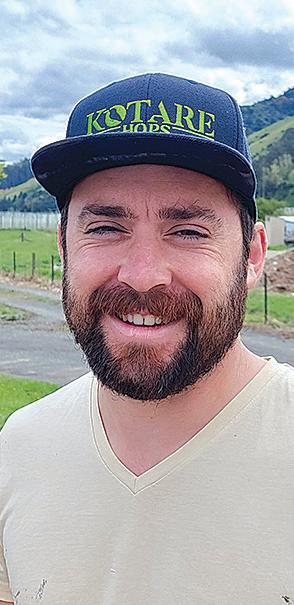
Noel says their daughter Laura is “the shepherd in the family,” caring for the sheep based at Kotare Hops and pitching in with her husband Shawn Bentham at harvest time.
While the original intention to move closer to civilisation hasn’t quite come to fruition for Noel and Debbie, it’s still on their life plan.
Come harvest time, they’ll join the family at Kotare Hops because, “someone’s got to be there to sweep the floor,” Noel jokes.
TOW BEHIND MOWERS
TOW BEHIND MOWERS
TOW BEHIND MOWERS
TOW BEHIND MOWERS
Kohler engines FROM $4,160+GST LOG SPLITTERS
Kohler engines FROM $4,160+GST LOG SPLITTERS
Made in NZ Kohler engines FROM $4,160+GST LOG SPLITTERS
Made in NZ Kohler engines FROM $4,160+GST LOG SPLITTERS

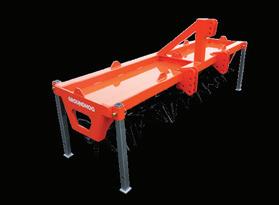







stock, motorised & tractor powered
CHIPPERS
CHIPPERS
Large range in stock, motorised & tractor powered
PTO Chippers - 3.5”, 5”, 7” and
PTO Chippers
Large range in stock, motorised & tractor powered
CHIPPERS AERATOR
CHIPPERS AERATOR
Nelson / Blenheim / Takaka / Westport / Greymouth
Nelson / Blenheim / Takaka / Westport / Greymouth
Available in 2.1m -3.6m
Visit us at 109 Bolt Rd, Nelson
Nelson / Blenheim / Takaka / Westport / Greymouth
FREE DELIVERY to Nelson / Blenheim / Takaka / Westport / Greymouth
Visit us at 109 Bolt Rd, Nelson
2.1m -3.6m widths - NZ
Visit us at 109 Bolt Rd, Nelson
FREE DELIVERY to Nelson / Blenheim / Takaka / Westport / Greymouth
Visit us at 109 Bolt Rd, Nelson
Visit us at 109 Bolf Rd, Nelson
Visit us at 109 Bolt Rd, Nelson

RURAL | LIFESTYLE | RESIDENTIAL 10 March 2023 Advert Farming TOP SOUTH MONTHLY
WARD
Peggioh Station
'Peggioh Station' is an east coast, limestone hill country farm comprised of 1304 hectares situated approximately 19km to the west of the small rural service centre of Ward.
After an extensive marketing campaign resulting in over 6500 views online and enquiry received from across NZ, resulting in 13 on-farm viewings. The deadline sale process produced a multi-offer situation for our vendor's consideration.



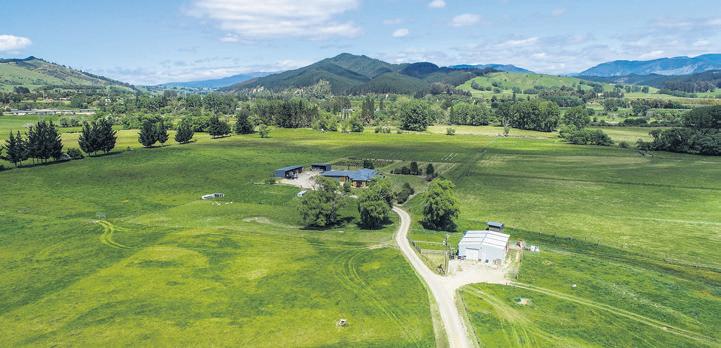


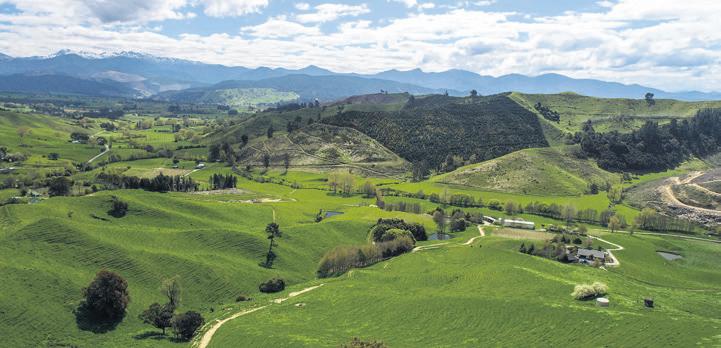



Congratulations to the successful purchasers who have now secured this large holding with huge potential. Thanks also to our loyal vendors who purchased this farm from us at PGGW. If you are considering selling your rural property call our experienced Marlborough team. We get results!
pggwre.co.nz/DAR36472
SOLD
Greg Lyons
M 027 579 1233
E greg.lyons@pggwrightson.co.nz


TAPAWERA
Quality living at Tapawera
4
Doug Smith
M 027 543 2280
E douglasjcsmith@pggwrightson.co.nz
Joe Blakiston
M 027 434 4069
E jblakiston@pggwrightson.co.nz
pggwre.co.nz/NEL36903
Appealing Dovedale Farm
Located in the desirable Win Valley and a real grass factory this 70ha (172 acres) property will appeal to astute buyers.


A meandering driveway leads to a stunning threebedroom, two-bathroom Adobe Brick homestead on an elevated site with ample garaging and storage. A designer kitchen and open-plan living are just some of the features of this impressive home. There is a full range of farm buildings and being well-tracked provides easy access to all areas of the farm. A very productive farm, ideal for dairy grazing, cattle finishing, or any class of livestock. Inspection will not disappoint.
pggwre.co.nz/NEL36422
SOLD
3 2 3
$2.4M Plus GST (if any)
VIEW By Appointment Only
Joe Blakiston
M 027 434 4069
E jblakiston@pggwrightson.co.nz
Doug Smith
M 027 543 2280
E douglasjcsmith@pggwrightson.co.nz
178.2049 Hectares – Mix of drystock grazing and forest woodlots being offered to the market for the first time in 51 years. Main dwelling built circa 1950’s, comprising three double bedrooms and open plan updated kitchen/living area with log burner installed for heating. Set in a sheltered sunny position. Farm improvements include a wide range of support sheds including a very large workshop/storage complex as well as a covered loafing barn, numerous other buildings plus a workers cottage.
Peter Evans
M 027 224 9798
Two water storage ponds add to security of stock water supply. Forestry includes several mixed species woodlots as well as recently harvested areas suitable for conversion back into pasture or replanting back into trees. 1 1
E pevans@pggwrightson.co.nz
pggwre.co.nz/NEL36547
Fern Flat Farm is a 260ha dairy farm, home to around 600 cows and located 16km from the Murchison township. Brendan and Ali Lochhead, who are 50:50 sharemilkers on Fern Flat, moved to the farm in June 2021 from Eketāhuna, in the Manawatu region, where they had started off contract milking and then leased a 250cow farm where they continued contract milking for a for several years. Affordable land prices in Murchison, family nearby and more land for their additional heifers they had raised, drove the move. While farming in Eketāhuna the Lochheads had been challenged with finding and retaining staff. “We also didn’t have any decent housing on the farm which added to our staffing problems,” Brendan says. With long hours and limited days off the couple decided they needed to change the way they farmed to increase their income so they could not only employ someone to provide flexibility around time off, but free up some time to look at how they could expand. This part was easier than finding reliable, willing workers.
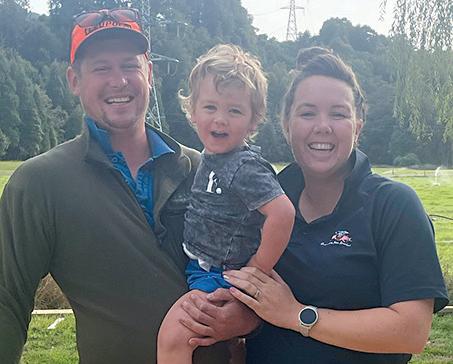

After trying multiple times to find staff the Lochheads tried a company called HelpX which is a cultural exchange for working holiday-makers looking for the opportunity during their travels abroad, to stay with local people and gain practical experience. The helper works an average of 3-4 hours per day in exchange for accommodation and food.
“It was great,” says Ali. “They were willing to help and keen to learn, they loved the farm experience. The downside was that they left.”
Further investigating for staff introduced them to the idea of migrant workers from the Philippines. So, they decided to try it. “Our decision to try it didn’t go down well with family and friends,” says Brendan.
“However, the fact remained we could not find staff, we needed to do something”. Felipe was their first migrant worker from the Philippines, who came to the farm with two years milk harvesting experience gained in Japan. Felipe is now in his 4th season with the Lochheads and is their 2IC. “It really worked out for us, but we also really tried to make Felipe welcome and part of our lives,” Ali says.
With the success of Felipe, the Lochheads continued with migrant labour and now have three full-time workers on
their farm as well as Brendan. “People might say we are over staffed, but we are here for the long haul we don’t want our staff working day and night and getting burnt out,” Ali says. The couple also have some changes coming up that are only possible because of the workers. “Come May we will be a fully self-contained unit, which wouldn’t be doable without the third worker,” Brendan says. “We are also increasing our herd by 50 cows and we will be putting one of our herds onto once-a-day milkings to really look after our young cows.”
The three workers use their wages to support family back in the Philippines who are in poverty with no job opportunities, no welfare system and have health care problems. “One of our workers has been able to send his kids to private school to give them a decent education to ensure they will have a job in the future.”
PGG
Our thoughts must go out to the residents of Cyclone-affected areas in the North Island - Just like our own Tasman flooding last year it is a terrible thing to see on such a large scale and we will all have to pay for the recovery either directly or indirectly. PGG Wrightson has a number of initiatives underway to assist in the area as well as coordinating several flood relief activities so we can all play our part in helping the flood-affected areas - our stores can assist with details.
I am not a climate change zealot, but we do have to recognise that the severe climate events we are seeing more and more frequently are causing more
and more damage to low-lying, coastal, or steeper areas prone to land subsidence. That is something we all must accept. In Marlborough’s case, the Wairau plains and rivers are the most heavily modified river system in New Zealand with almost all of our rivers having been diverted or channelled over the years. Blenheim was previously known as Beavertown and had a history of flooding multiple times a year. The work done to control the Wairau, Fairhall, Omaka and Taylor Rivers has led to the wonderful viticultural plains we have now. Yet I go back to reports from the mid1990 and the landcare experts were warning of shingle buildups, risk of flooding, and steps we need to take to protect our farmland and towns even be-
fore climate change was an issue. The Wairau River flood protection held firm in 2022 flooding (just) – maybe in the light of recent events, this should be reviewed as it is our one insurance policy against a growing problem.

On a positive note, though the South Island has experienced a pretty good summer and I hope ideal autumn conditions continue for the next few months as harvest is upon us and farmers are in the middle of stock sales so the amount of grass around is allowing them to get more weight in despite the falling schedules.
I hope all our clients are able to enjoy our wonderful region in the coming months - see you at the Power Boat racing at Rotoiti on March 11th and 12.

There is a vital need for greater investment into agricultural research in the light of the climate change debate, says West Coaster Katie Milne.

Katie was the former NZ Federated Farmers national president and was elected as the new vice-president of the World Farmers Organisation at the WFO General Assembly in Budapest in mid-2022.
“What’s missing in the climate change debate is the need for a huge investment into research to increase productivity while curbing emissions,” she says.

“Unfortunately, there’s a tendency by some vocal groups in their zeal for addressing climate change to lose focus, and instead of working with farmers, to attack them.” Her comments were in response to overseas news of radical measures being introduced that threatened the operations of farmers even to the point of closing them down.
Dutch farmers have been generating global headlines with protests described by Netherlands Prime Minister Mark Rutte as
“damaging and threatening”. But Dutch farmers existence is being endangered and threatened by immense pressure to make radical changes to cut harmful emissions.
Some farmers fear their livelihoods will be obliterated. Dutch government proposals for tackling nitrogen emissions indicate a radical cut in livestock.
‘Woke Wave Washes over World’s Agriculture’. Extreme anti-climate change measures are seen as part of the ‘woke culture’.
“As the woke wave continues to gain momentum, some worry it will have a tsunami impact on agriculture. The fears have merit,” wrote Kevin Hursh in ‘The Western Producer’ on 2 February.
“The most blatant example is European farm policy mandating less fertiliser, fewer crop protection products and more organic production.
“The measures are particularly severe in the Netherlands where agriculture is in a downward spiral with thousands of farms being expropriated.

“The Canadian issue sparking the most controversy is the 30 per cent reduction target for fertiliser emissions.
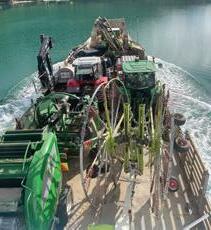
Meanwhile, in the Netherlands, Dutch farmers are under immense pressure to make radical changes to cut harmful emissions and some farmers fear their livelihoods will be obliterated.
Farmers are not after hand-outs; they just want to strive for better production enhanced by lower emissions.
“No one denies the climate is changing.
“It does naturally go in cycles, but we want to mitigate any effects any human activity and in this case farming, has,” she says.
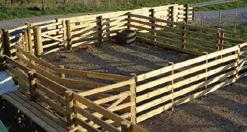
“Against some of extreme anti-farming groups, the reaction of farmers is why are we being kicked in the guts when we are the most efficient in the world in terms of producing food and minimising emissions.
“We just want that recognised and that we are striving to be even more efficient on both scores.”
Katie is calling for a change in focus.
One report estimates 11,200 farms will have to close and another 17,000 farmers will have to “significantly reduce livestock.”
Meanwhile, across the Atlantic in Canada, ‘The Western Producer’ featured an article head-lined
“Although the government continues to maintain this will never mean a mandated reduction in fertiliser use, some farmers and farm groups are sceptical.
“The government used to promise that firearms would never be confiscated and look how that has evolved,” said Kevin Hursch.
“It’s in our blood, I want to do this, and if we have to adapt to new situations, I want to, but we have to be fair, it takes timegive me a chance,” says Geertjan Kloosterboer, a third-generation Dutch dairy farmer. Here in New Zealand and from the West Coast, Katie Milne expresses similar thoughts.
“It’s currently too negative, too much in restriction mode and reducing farming rather than being positive in aiming for better and cleaner production,” she says. “And if government is sincere and serious about the climate change issue, that requires investment much more than the meagre that 3 per cent of climate mitigation and adaptation investment worldwide goes into agriculture.”
Continuing support for Federated Farmers is vital in the face of often ill-conceived policy and legislation from central government said Marlborough Federated Farmers president Evan White to the monthly meeting.
“At a farmer level I am constantly hearing of more and more farmers with low morale,” he said. Interest rates have risen and mortgages have increased while overdrafts are on the rise.
“As farmers we can handle so much but on top of these facts it’s all the constant barrage of poorly thought out legislation coming our way from Central Government that I believe is creating the most uncertainty in Rural New Zealand,” he said.
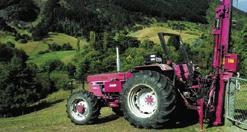
Evan White said the more he is involved with Federated Farmers, the more he appreciates the valuable work the organisation is doing.
“The concern I have is
what policy has slipped through or could slip do so in the future that could have dire consequences for rural New Zealand and so farmers must continue to support Feds -and more so - and the very able policy team who work tirelessly for farmers,” he said.
Forestry sector chairman Chris Dawkins said he had read with interest Minister for Forestry Stuart Nash’s forestry transformation plan to move forestry’s focus from logs to high-value wood products in coming years.
Minister Nash hailed it as an aspirational document providing a road map that includes lifting the sector’s export earnings for value-added wood products by $600 million by 2040. The plan’s key initiatives include diversifying away from pinus radiata to alternate types to account for 20% of plantings by 2030.
However Chris Dawkins said the merits of the plan were debatable when New
Zealand radiata is the most productive, fastest growing timber in the world. At present about 10 percent of New Zealand’s exotic plantations are non-radiata. Forestry is now sitting alongside horticulture in terms of export receipts but it can grow from $6 billion per year to over $11 billion by the end of the decade.
“However the minister’s plan fails to address a forthcoming slump in New Zealand’s timber harvest, with volumes predicted to drop from about 35 million cubic metres per year to 25 million cubic metres in only a decade’s time,” said Chris Dawkins.
In his dairy section report Evan White described the current season to date as “nothing short of a nightmare” trying to get cows and service bulls into the works.
“So best book culls in early but be prepared for delays and budget on feeding them longer than usual,’ he said.

Unfortunately, there’s a tendency by some vocal groups in their zeal for addressing climate change to lose focus
Katie Milne

The government’s reshuffling of ministers is a retrograde step for the environment, conservation and outdoors says the Council of Outdoor Recreation Associations of New Zealand (CORANZ).
CORANZ chairman Andi Cockroft described the cabinet reshuffle announced by new Prime Minister Chris Hipkins as “bizarre” in the light of mediocre ministerial performances in the past by some still remaining in highly-ranked portfolios and/or cabinet rankings.
“Many of the one million plus New Zealand recreational fishing public will be very disappointed that David Parker has lost Ocean and Fisheries. Making the reinstatement of Nash to Ocean and
Fisheries makes the switch even more illogical and puzzling,” said Andi Cockroft.
Stuart Nash was minister of fisheries in the newly-elected Labour-led coalition in 2017 but was replaced by David Parker in late 2020.
“Whereas David Parker showed he could, in the public interest, stand up to ministry bureaucrats and corporate fishing industry influence, Stuart Nash in his three years as Minister 20172020, seemed a lapdog to both the ministry and industry,” said Andi Cockroft.
CORANZ viewed the retention of David Parker as Minister for the Environment as good. However, there was disappointment in the Conservation portfolio now held by Willow-Jean Prime, be-
ing a minister outside of Cabinet.
“The inescapable conclusion is that the Labour, despite being in near coalition with the Green Party, does not rank conservation highly. In view of the state of deteriorating rivers and other environmental problems, that is very sad,” he said. It was also puzzling and disappointing that David Parker was now ranked number 14, well below mediocre, arguably incompetent, ministers above him, he added.
The recreational hunting public and firearm-owning public will view with deep misgivings the reinstatement of Stuart Nash to Minister of Police. As with the fisheries portfolio, Nash served as Minister of Police from 2017 to 2020 and was then replaced
Sequestration is broadly defined as selecting, removing and taking from an owner. This is what is proposed for farmers’ land.
Although government is not encouraging farmers to focus on adaptation strategies to counter global warming, it is reconsidering sequestration to generate carbon credits to offset national emissions.
According to the Climate Change Commission, this is for a cleaner, greener, healthier, more sustainable NZ.
Even although commitments to our targets are not compatible with the global 1.5C target, or Paris Agreement 2.1 (b), that reducing emissions will not reduce food production.
Farm reporting for livestock emissions will be complex, time-consuming and expensive for the required accuracy and integrity, and also expensive for government to monitor and audit. And cost farmers a levy.
The Climate Change Response Act 2002 defined landgrowing, sequestered-eligible trees as a minimum 1ha lot, with specified trees over 5m high and minimum 30 per cent canopy, like natives, or 30m wide shelterbelt.
But forestry carbon calculations are complex and miscalculations will be penalised. As if taking land from farmers is already not enough penalty
when they have voluntarily offset 33 per cent of emissions from 1.4m ha of native forest according to MfE. MPI projects that growing more trees will remove 1.46m ha or 15 per cent of farmland from food production.
Perhaps government should encourage farmers to provide other sequestration solutions, and also recognise standards used by our market countries for that, as well as satisfying their imported food standards.
UK Climate Change Commission proposes increasing current 475K km of hedgerows by 40 per cent to contribute to UK’s net zero targets because hedgerows offset 0.66-3.3 tons CO2 per ha annually.
How about our existing riparian plantings storing 3.4 tons per ha pa?
Or how about bamboo with 600 varieties, some if which grow readily here depending
by Poto Williams. During Nash’s tenure, the Mosque shooting by an Australian terrorist saw panicked, urgent, but futile law passed about firearms.
“The rushed law was predictably poor law and in fact aggravated the situation, with gangs and criminals better armed while government and police wrongly targeted the law-abiding firearm-owning public.”
Andi Cockroft said political history revealed that governments hoping to avoid election defeats which had rearranged cabinet, often were dismissed by the public at election time.
“History strongly reflects that any Prime Minister who believes a government’s flagging political fortunes can be revived by an election year reshuffle is being a
cock-eyed optimist,” he said. Prime Minister Hipkins described his latest cabinet makeover as demonstrating the depth of Labour’s talent that has brought some new energy and focus to the task ahead. But Andi Cockroft said, contrary to the PM’s description, the cabinet reshuffle suggested a lack of depth of ability.
“But very importantly, CORANZ is extremely disappointed that government has a low priority for conservation when so many matters such as rivers, monocultures of pines through the carbon trading farcical fad, foreign ownership, the Urewera National Park shambles, corporate monopolistic sea fish quotas and other issues need urgent attention,” he said.
on soil and climate, and can grow up to 5m high in one year?
Lately, we have been walking and sleeping on it and wearing it, but ignoring that it sequesters carbon up to five times that of ETS-promoted pine trees.
And the double whammy benefit of replacing steel and other materials to capitalise on its tensile strength, as visitors to Asia would have seen in multi-storey scaffolding.
With preservative, bamboo can be used for products ranging from reinforcing to fence battens. Or chopped for animal bedding or burnt for energy. Harvesting bamboo is the same as harvesting pine trees. Government insists that any revisions must be based on accepted science as an improvement on the previous legislated definitions.
Hopefully, taking farmers’ land will use a farms-systems approach for economic, environmental and social reasons that each farm business uses for bottom-line profit.
Not by one-size-fits-all ideology with questionable rules, and plant species for other agendas. Government has couched sequestration as support for farmers.
Another view would be usurping private property rights, and reducing food supplies by breaking our international commitments not to do so. And increasing food prices.
A fledgling political party has attacked government’s promotion of carbon farming as destroying rural communities and New Zealand’s outdoor way of life.
Alan Simmons, president of NZ Outdoors and Freedom Party, said the real problem, as overseas speculators encouraged by government buy up sheep and beef farms, will be the huge social upheaval due to the stripping out of rural communities.
“Whole areas will be depopulated by farmers moving out. Shepherds, shearers and other farm contractors are no longer required, rural contractors such as bulldozer drivers and haymakers close down, as do the local schools and the vet,” he said.
Alan Simmons said many other businesses serving the farming communities will also suffer as rural depopulation takes place because of government’s active encouragement to overseas-based “carbon farmers”.

“The Labour government and its former coalition partners NZ First and the Greens, made some shocking but little-known changes in 2018. As a result, their vision for planting one billion trees seems to have become immeasurable harm from clear-felling, monoculture,
pine slash, and storm-generated log flumes smashing bridges as they wash down swollen streams”. He said government incentives to speculators have prioritised “green washing” over food and people values, converting productive farmland to pine monocultures.
“It’s destroying communities as investors greedily farm thin air – in the name of carbon credit farming.” Commercial forestry and “carbon farming” is resulting in New Zealanders losing their traditional access to outdoor recreation.
The locals who previously accessed that land for hunting and fishing or recreation, are now unable to enter these carbon credit forests as they have no access, with padlocked gates and trespass signs erected.
“This connection to our rural roots will be lost as farming families sell up or local farmers can’t afford to buy, competing against the massive carbon credit ‘farmers’. These forests, locked up for 50 or so years with no real work involved, will destroy rural New Zealand,” said Alan Simmons.
The Labour-Greens government has eased overseas investment restrictions and have created a loophole for the mass overseas purchase of land and transferrable carbon credits that offer nothing of benefit to New Zealand and serious erosion of rural New Zealand.
Recently, a major end-user in the UK specified that they would now prefer to buy products from New Zealand that were grown or raised on reduced nitrogen and phosphate land. We believe this is a start of a new trend that will be here to stay.

Rolling to steep sheep and beef unit at Ballance. We first applied at Functional Fertiliser mix in 2010 and have applied to 85ha every year since.
We have enjoyed outstanding animal health with both sheep and beef animals regularly achieving top prices at the local sales yards. Independent analysis showed our soil quality to be second to none.
– GRAEME AND JUDY OLSENFunctional Fertiliser applications over four years have transformed our rotationally grazed pastures into a highly productive summer dominant clover sward.
The “fertiliser’ soft carbon combination brought our soil and pasture to life with amazing alacrity.
Our spring pasture growth supported a stocking capacity of 40 su/ha with the pastures still requiring topping. The Functional Fertiliser wrap around support service has been exceptionally helpful.
– LINDSAY
This stuff is amazing. I have clover coming up where there was none before, thanks!
– LANCE UNSWORTH
We have a small organically registered farm near Otaki specialising in cattle finishing. In the 8 years since applying Functional Fertiliser no nitrogen has been applied and the changes have been exceptional with very strong clover growth providing all the nitrogen required. It took a little time to kick in however our animal health has been exceptional with no lice or worms and very few vet bills resulting in a low cost easy to manage and profitable operation. The property is at least carbon neutral, and the pastures largely look after themselves. The stock agent says we fatten cattle quicker than others with two year old carcass weights of 280 – 300kg with the meat having exceptional flavour.
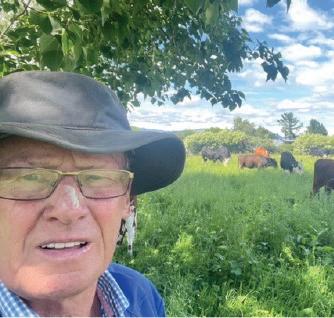
Our costs are 30% less, with 30% less labour required. We run fewer animals with a 30% increase in overall profitability. It’s an easy-to-follow system that is equally successful on both large and small operations. Functional Fertiliser really works. It sweetens the soil creating the ideal environment for mycorrhizal fungi and beneficial microbes resulting in strong growth throughout the year.
 – STUART PRITCHARD
– STUART PRITCHARD
WE HAVE THE ANSWER TO MAINTAIN HIGH PASTURAL YIELD WITHOUT FERTILISER NITROGEN

New Zealand Winegrowers (NZW) welcomes Catherine Wansink on a part-time secondment as Australia market consultant. Catherine currently holds the position of Commercial Business Advisor at New Zealand Trade and Enterprise (NZTE) and supports the growth of New Zealand exporters largely in the premium beverages space.

“With Australia being the third largest export market for New Zealand wine and arguably one of the toughest to operate in, we’re eager to ‘turn up the noise’ on New Zealand wine over the Tasman. Our goal is to reinforce the premium positioning of our wines, and further support New Zealand wineries already there, and those who may wish to have a presence in the future,” says Charlotte Read, General Manager Marketing New Zealand Winegrowers.
“Utilising Catherines’ extensive experience in the wine industry on both sides of the Tasman is hugely beneficial for the connection she

provides New Zealand wineries navigating the challenges of operating in the Australia market. We feel very fortunate that NZTE are formally supporting NZW to achieve our goals to protect and enhance the premium reputation of New Zealand wines in the Australia market.”
During her secondment, Catherine will focus her efforts on sharing the latest New Zealand wine stories and the new ‘Altogether Unique’ brand platform, connecting with those who can amplify this story and bring it to life through targeted in-market activations.
“We are delighted to be able to further support the growth of New Zealand wine in the Australia market by investing in the ongoing partnership between NZTE and NZW, to assist exporters businesses to grow and thrive,” says Glen Murphy, Regional Director Australia Pacific, New Zealand Trade and Enterprise. To get in touch with Catherine, please email catherine. wansink@nzwine.com.
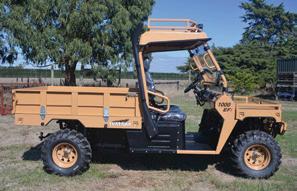
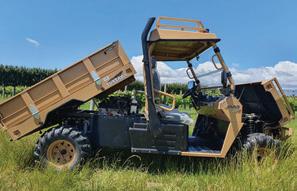

DairyNZ’s chief executive has announced his resignation after 15 years in the job. Tim Mackle, who was involved in the levy body’s formation back in 2007/08, said he felt extremely privileged to have had the opportunity to lead and help develop DairyNZ’s solutions and services on behalf of its farmer members.
Mackle said he would stay on as chief executive until the end of June to give DairyNZ’s board time to recruit a successor. “I am proud to have had the opportunity to lead DairyNZ over this period, the dynamism and constant challenge and change in our
sector has made it an exciting and purposeful role.” He said a highlight of his time in the role was the progress farmers have made around sustainability practices. “Particularly over the last 10-15 years. There’s always going to be a need to keep doing better on farms, but it’s important we do acknowledge the progress made by our farmers and sector.
Tim MackleStephen Todd, Nelson Federated Farmers chairman says, “Tim Mackle has made a huge contribution to the NZ dairy
sector which has in turn greatly benefited the New Zealand economy.” Federated Farmers president, Andrew Hoggard acknowledged Tim’s contribution also, saying, “Tim led DairyNZ through a period of immense industry growth that saw the sector become New Zealand’s biggest export earner and a vital industry. Under Tim’s leadership, there has been support for farmers to improve environmental performance and adjust to increasing regulatory compliance.”
With the recent reshuffle of cabinet, I have gained some new Ministerial colleagues and I want to take the opportunity to acknowledge their appointments and their work ahead. It’s a pleasure to have Kieran McAnulty as the new Minister for Rural Communities. I valued the work in the Rural Communities portfolio immensely. It goes to the heart of why I got into politics in the first place. It’s great to have Kieran in the role, as it provides another advocate at the cabinet table and helps me balance domestic travel with my international travel as Trade Minister. Kieran will hit the ground running and he has a head start after meeting with all 54 rural and provincial councils last year when he was Associate Minister for Local Government. And outside the cabinet room, Jo Luxton is on the ground in her new role as Parliamentary Under-Secretary to the Minister of Agriculture. That title is a bit of a mouthful, but what it means is that Jo will be another voice advocating for and support-
ing those in the primary sector. Being based in Ashburton and having been the Chair of the Primary Production Select Committee, Jo knows the lay of the land. It’s going to be fantastic to work together on boosting the already huge success of our primary sector. As we keep on with the recovery from Cyclone Gabrielle and the Auckland storm, it feels like a pertinent time to be looking forward to what the future holds. Both storms saw the tragic loss of life and our hearts go out to those families grieving loved ones. In recent days I went to Northland, Pukekohe and Hawke’s Bay to look at the damage and listen to the myriad issues farmers and growers are facing. It’s particularly devastating in Hawke’s Bay, where there’s a high density of capital infrastructure and intensity of orchard and farming operations. We’ve announced $50 million to kick-start the recovery work on top of an initial $4 million mobilise the response in the
days after the cyclone. Gabrielle’s impacts have been widespread and severe and MPI is working on the ground with sector groups to make sure the funding goes where it’s needed most. Climate change means that these events are going to become more frequent. It was said Auckland was a one in 200 year storm, but in the future that may become a one in 50 year or 20 year or 10 year. Who really knows?
Damian O’ConnorIt was a similar thing with the Ashburton floods of 2021. What’s evident is that we need to re-think the capacity of the infrastructure systems we build, the materials and methods we use, and how we situate them. As farmers and growers, we’re exposed to shifting climatic conditions. Storms like these will require us to rethink our businesses in similar ways.
It’s good that we’ve passed the debate on whether climate change is a reality and can focus on what we’re doing about it.
WELSH BLACK CATTLE OPEN DAY | 18th March, 10am to 3pm
Electric & Petrol, purpose-built for off-road travelling, designed specifically for New Zealand conditions. Rugged, dependable and powerful! COME AND CHECK THEM OUT NOW!

11 Jacks Road, Renwick 03 577 5508 sales@cmmechanical.co.nz
www.cmmechanical.co.nz

Welsh Black cattle have a history of being raised in harsh outdoor environments and unimproved pasture, and have an ability to convert rough feed into weightgain and a willingness to forage. They are docile and have a strong constitution and fertility. Cows have a long productive life of 15-20 years, and are easy calving and feed their calves well, with a long even lactation. Cows average 600-800kg, bulls 900-1300kg.
As eating beef, the Welsh Black meat is finegrained and lightly marbled with good flavour, with excellent cuts for the butcher. They fatten readily on good pasture but do not tend to go overfat, and well-finished steers can yield 68% CW. Seventy 18mo steers finished on a grain feedlot averaged 500kg with no overfats. Growth rates are excellent on grass, with
such examples as three hundred 20mo steers averaging 294kg CW, and a similar number of 20mo bulls ave 304 kg CW. Hill country station bulls ave .76kg/day weight gain, to be 503kg at 18mo old. One of our grass-fed young bulls weighed 600kg at 17 months old.
For the weaner cattle market, the cows are outstanding in producing top calves to terminal sires, especially those which colour-mark such as Hereford or Charolais.
Our herd features horned and polled cattle, with a range of stud bulls and cows with calves at foot.
Visit www.welshblackcattle.co.nz
Edwin and Margaret Foord, 03 522 4233 81 Kereru Road, Tui (off the Tadmor-Glenhope Road, about 25km from Tapawera.)
Our Rural team is here to help you navigate the raft of new legislation and information facing our rural communities.
We can provide advice about biodiversity, riparian and wetland enhancement, funding options, erosion control, pests and weeds, wetlands, fish passage, freshwater and estuarine ecology, soils, land use, forestry, regulatory requirements and a whole lot more.
Please do not hesitate to get in touch with us via email rural.info@ tasman.govt.nz or phone 03-5438400
The new stock exclusion regulations are being phased in from 1 July 2023. From this date dairy cattle, pigs, intensively grazed beef cattle and deer must be excluded from rivers, lakes and wetlands on pastoral land.
Stock must be excluded with a 3 metre setback from lakes and wide rivers, and excluded from wetlands, there is no minimum setback distance for wetlands.
The regulations do not specify a particular method to be used as long as stock are effectively excluded with the 3 metre buffer, so permanent or temporary fencing measures are acceptable. A barrier is not required around or along an entire lake, river or natural wetland. If there are no livestock present at a particular time, then no barrier is required.
If you have existing fences or riparian vegetation which excluded stock prior to 3 September 2020 you do not need to replace or move it, however this fence must be a permanent fence and the fence and/or vegetation must be maintained to ensure that it continues to exclude stock from the lake or river.
Tasman District Council has a new Stock Droving Bylaw.
Its purpose is to provide for the safe and orderly droving of stock along and across all roads within the district.
It’s also designed to protect the safety of all road users and ensure the protection of freshwater from stock effluent on the road reserve.
The Council is running a special webinar, in association with Federated Farmers, from 7.00pm on Tuesday 21 March to explain the ins and outs of the bylaw and answer your questions.
To register for the webinar, go to Tasman District Council’s website tasman.govt.nz and search Stock Droving Webinar.

Further resources can be found on our Tasman Rural Hub page www. tasman.govt.nz, search ‘tasman rural hub’. It’s a comprehensive information source for farmers and rural residents, with a section devoted to small land holdings. Covering all you need to know about on-farm regulations, mitigation, biodiversity, and biosecurity, we’ll be keeping this section updated with any relevant information that will be useful for those in the rural sector. Be sure to visit the support and funding section to discover what help is available.
Intensive winter grazing is now a regulated activity. Council staff have been working with farmers over the past couple of seasons to ensure we all understand the permitted conditions and best management practice requirements for winter grazing.
There has been a lot of positive engagement and awareness from landowners and industry groups around this topic and it is pleasing to see that on the whole farmers are following good management practices.
One of the key triggers for landowners is the slope of the cropped paddock where the maximum slope must be less than10 degrees. If you think your paddocks may not meet the slope requirement or any of the other conditions or you
The application of synthetic nitrogen fertiliser to pastoral land is now capped at 190kg /ha/yr, this limit applies both as an average for the farm and to each hectare (with a limited exception for land used to grow annual forage crops).
Our Dairy Farmers are now required to record their synthetic nitrogen use and report it to regional council by 31 July each year. This date was extended last year, and we have received
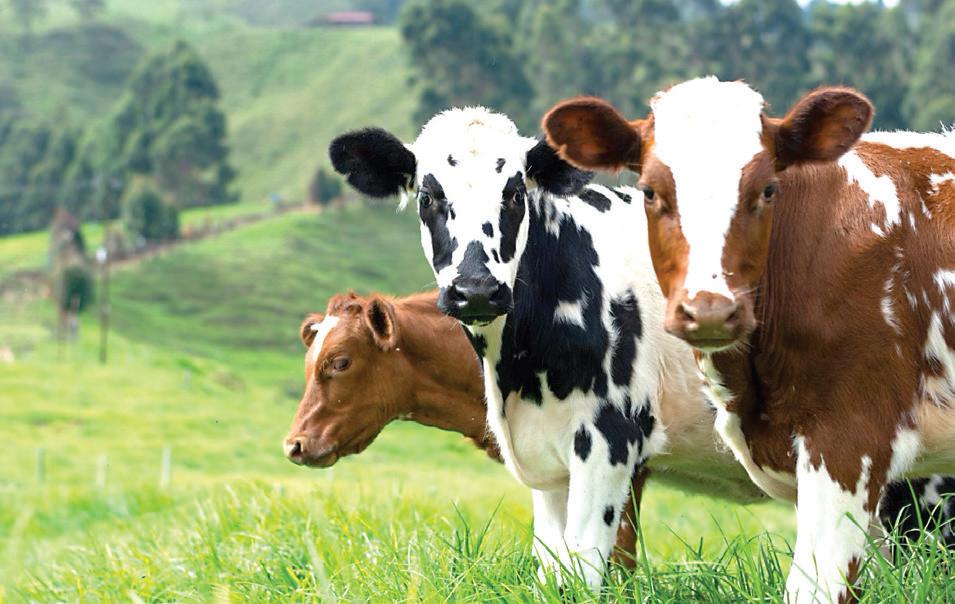

have any questions, please get in contact with our Rural Team at Council. We are here to help and can advise alternative options and whether resource consent may be required in the interim prior to the roll out of Freshwater Farm Plans.
information from just over half of our Dairy Farmers so far.
If you are a dairy farmer and have not yet put through your synthetic nitrogen fertiliser use for the 2021 -2022 year or if you require help with this, please contact your Ravensdown or Balance Agri-Manager or one of the Rural Team at Council.
The Best Land Tasman Has To Offer 127 Redwood Valley Rd, Redwood Valley


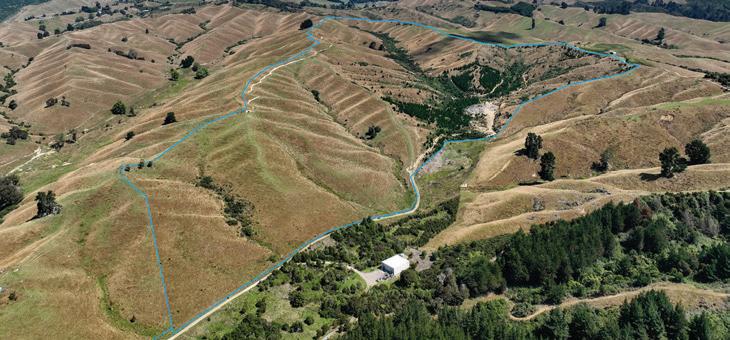
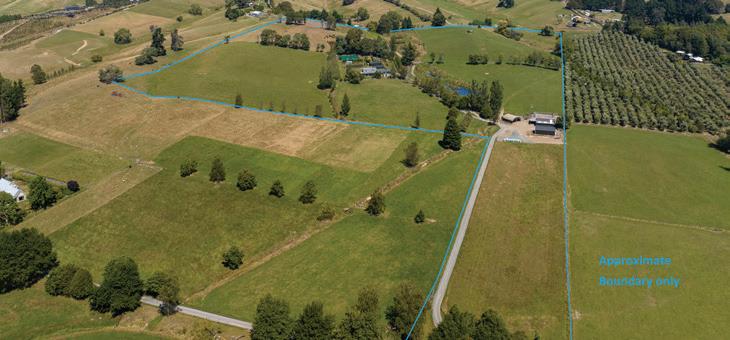
Attention all farmers and land enthusiasts! Are you looking for a piece of paradise to call your own?
Nestled in the stunning Redwood Valley, this block of land boasts productive flats, rolling fields with fertile soil and natural water as well as Redwood Valley Scheme. Substantial renovations have been undertaken on the home in recent years, including new kitchen, retrofitting double glazing and some internal layout changes to utilise the most of this 4/5 bedroom homes spaces and the fantastic outdoor areas. No expense has been spared when it comes to the land either, from fencing, concrete pad Te Pari cattle yards, workshops and implement sheds – it has certainly been done right the first time. Don’t miss your chance to own this beautiful property is such a sought after location.
Tender Closing Wednesday 29th March 2023, 1pm

Toby Randall M 027 233 9170 toby.randall@harcourts.co.nz
Secure your future with this rare opportunity
223 Rose Rd, Upper Moutere

Unleash your potential with this breath-taking bare land block in Rose Road, Upper Moutere. With 60 Ha approx. of rolling to hill grazing, 40 Ha of those being clean grazing land, and the remaining 20 Ha being ex forestry land that the current owner has converted back to pasture. A lot of the hard work has really been done here, returning the cutover block back to grass, leaving a small block of more concentrated regenerating pines with a bit of regen on the balance – ideal for a future woodlot, shelter for stock, or maybe finish what has been started and get it all back to grass. Water is via the Dovedale Scheme as well as natural water sources. Contact me now to arrange a viewing and discover the possibilities.
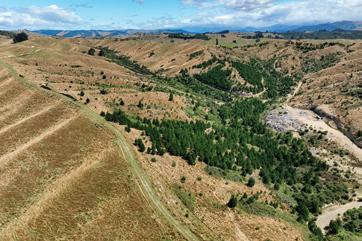
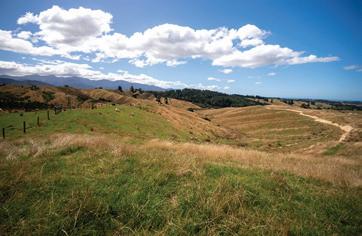
Tender Closing, March 8th 2023
Toby Randall M 027 233 9170 toby.randall@harcourts.co.nz
Elevate your lifestyle with this luxurious architectural 3 /4 bedroom home. The various spaces are certainly designed to impress and make the most off the all day sun. High end, well executed kitchen, spacious open plan living that flows to a great outdoor entertaining area with inground salt water pool – finished with the addition of a well appointed pool house with own ensuite bathroom. The land is some flat with mostly rolling pasture, good water supply and a 4 bay shed/ worskshop and room for all the toys. Enjoy the best of both worlds, with this property only a short drive from Brightwaters or Wakefield’s local amenities.
Tender Closing Wednesday 15th March 2023, 1pm
Toby Randall M 027 233 9170 toby.randall@harcourts.co.nz




The Ultimate Lifestyle
0 Shenandoah Hwy
Lifestyle bare land blocks such as Waiparanui that is just south of Murchison and tucked up in its own slice of paradise do not come up for sale very often. Elevated and sunny with panoramic views out to the mountains in all directions, 6 Ha (approx. subject to final subdivision) surrounded by native bush and even room to run some stock. There is a creek running through the property. The hard work has been done during the subdivision with a stylish entrance, formed and solid driveway, culvert over the creek and to top it off a brand new three bay shed. Towards the base of the property is the Maruia river with a private swimming hole and fishing, you can’t get more idyllic than that! May it be a permanent base, a holiday destination, a hunting/fishing opportunity – it is all waiting for you to add your own stamp on the property.

Deadline Sale 16 March 2021 at 1pm
Sharyn Miller M 021 377 930 sharyn.miller@harcourts.co.nz


Saddle Up For Yor Next Adventure
71 Gibbs Valley Road, Wakefield
Gallop towards your dreams with this breath-taking 46HA approx block in Gibbs Valley. With a combination of flat fertile paddocks and some rolling hill grazing, this property offers gorgeous views out over Richmond and the bay. The purpose built arena and stable facilities are a horse lovers paradise and further farm improvements include excellent cattle yards, fully operational shearing shed and large 4 bay shed, with one bay being converted to an office space. Two self contained tiny homes could be your base will you build your dream home, or offer a possible income stream in the future. Don’t miss out on this rare opportunity, contact Toby today.
Tender Closing 22nd March 2023, 1pm

Toby Randall
M 027 233 9170 toby.randall@harcourts.co.nz
Seriously
77
Looking for a peaceful escape in the country – well look no further. This spectacular property has so much to offer its next owner. Approx 18.3 HA of rolling hills- 12 HA of forestry, with a second rotation of young pine trees and all the tracks and skid sites ready. There are options to explore when it comes to registering the property in the ETS for Carbon Credits. The impressive and solid 1990’s home has been renovated throughout the years, offering 4 bedrooms, 2 living, 2 bathrooms and double garage with lean to. Step out onto the large deck and enjoy the stunning views. The land around the house is an easier contour, surrounded by mature and established trees, with room for the animals. You certainly wouldn’t regret investing in your family & future when it comes to this great piece of real estate.
Offers Over $1,570,000 + GST (if any)
Toby Randall
M 027 233 9170 toby.randall@harcourts.co.nz






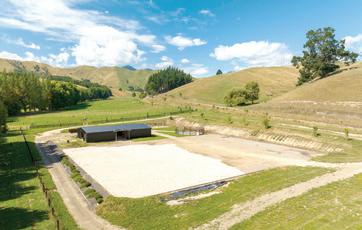

Often maligned Forestry is an important contributor to the region’s economy.


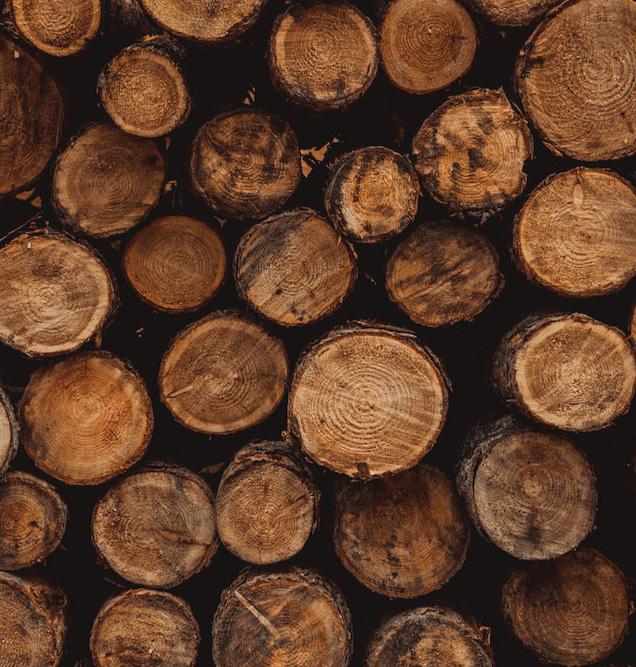
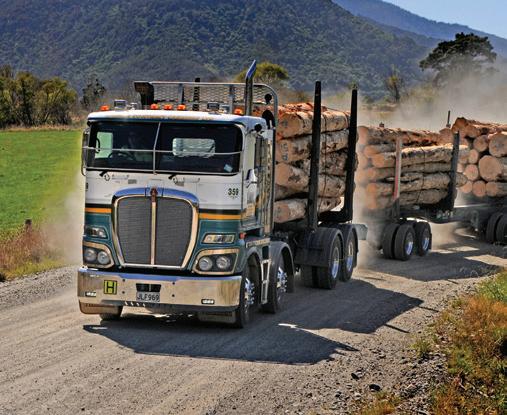

It provides jobs, trees sequester carbon plus well-tended and harvested properly has its place on many farms in the region.


Murray and Vanessa Earwaker, have 180 hectares of Pinus radiata forest and they say, “forestry is a bread-and-butter option for many, provided it is done right plus it’s a way to plan for farm succession.”
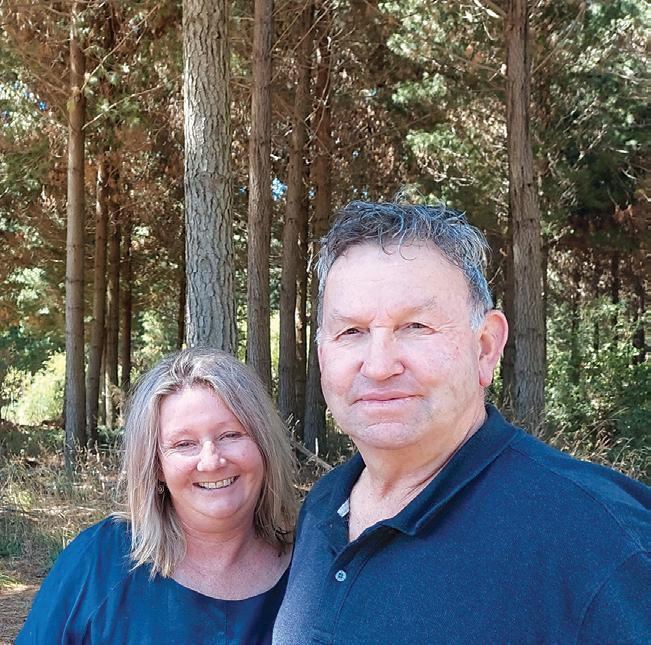

They purchased their block in 2014 and with careful planning by the original owner the trees were staggered for the harvest of thirty hectares every three years and then replant to keep the rotation going.

The infrastructure, skid sites and roading were all in place, as a system their future looked secure.

Five years into their project the Pigeon Valley fires happened,
and they lost 150 hectares in the fire. After the fire, what stopped them from total devastation was the fact they had insurance.
They’d lost the bulk of their future income, there was a big expensive clean up job as standing spars still had to be cleared to get the land back to planting condition again.
This was not the first time the Earwaker’s have been hit by fire.
The family house caught fire in 1997 on their Korere farm from which they escaped with nothing.
How did they recover after two major disasters? Vanessa says.
“It was tough losing all their personal possessions and especially dealing with Insurance loss adjusters at that time.”

After the Pigeon Valley fire they were relieved to find their Insurers we so much more helpful to deal with giving good advice
to reaching positive outcomes for both parties.


“Right from year one we’ve just had to believe in what we were doing to carry on,” says Vanessa.
Murray strongly advises anyone with a forest to have insurance. We aim for a 20 year rotation due to the risk of windthrow in our block after year Twenty. He also added, “there’s future potential for using forestry slash as biofuel, but currently there is no infrastructure to support it.” “It will come though” responds Vanessa.
The Earwaker’s have replanted 150Ha in Pinus and their 4-year-old trees are looking good on their hills. They would like to add more diversity to their crop and have planted a few Redwoods, Larches, Eucalyptus and Japonica but say longer rotation species are a luxury they can’t afford yet.

There is a myth that the government relaxing the rules around structures no bigger than 30 square metres means you can have a tiny home on your property. As with any change in rules it comes with conditions and limitations, and in this case does not extend to the obligations under the Resource Management Act, or development contribution payments under the Local Government Act. Furthermore, the change in rules under the Building Act does not extend to structures containing kitchens. For anyone thinking about building or locating a tiny home on their property, it’s important to understand your obligations under the District Plan. A tiny home is considered to be a dwelling under most district plans and all of the rules relating to a larger home also apply to a tiny home. There are some exceptions to enable minor dwellings or granny flats to share a property with a primary home, however for the most part they are treated as if they were a full dwelling. This means provisions such as minimum area per dwelling, setbacks from boundaries, height to boundary relationships, and maximum amount of site covered, will continue to apply to the tiny home. These rules apply often regardless of the small scale of the building, with resource consents required for any non-compliances.
Development contributions are levied under the Local Government Act whenever a property is subdivided, or an additional dwelling built, if not located on a separate title. These are levied per household unit equivalent and contribute towards the district-wide roading, community
services, and infrastructure (water supply, stormwater and sewer connections). While some councils may allow up to 50% discount on development contributions for tiny homes to acknowledge they are small and will place less pressure on some regional services, a contribution is still required. This varies between councils, with prices known to reach $45k per new household in some districts.

Often when purchasing a tiny home built off site, the building companies will give the option to have one with, or without, a building consent. Each tiny home placed on a property with permanent foundations and plumbed into council services will require a building consent from the district in which the budling was constructed, and a building consent for the connections to the local council infrastructure in the district it’s located. Additionally, the Government’s 30 square metre exception to the Building Act comes with a whole list of exceptions and exclusions, meaning permanent structures containing kitchens require a building consent.
Unfortunately for many people who think they will be saving costs, the fact you are building a separate house means tiny homes are still subject to the same level of compliance with district plans, the same obligations for development contributions, and the same obligations for a building consent as a standard dwelling. Due diligence before joining the tiny home revolution is highly recommended.
Anna Bensemann, Senior Planner, Baseline Group Marlborough, Phone: 03 578 7299, Email: marlborough@ blg.nz
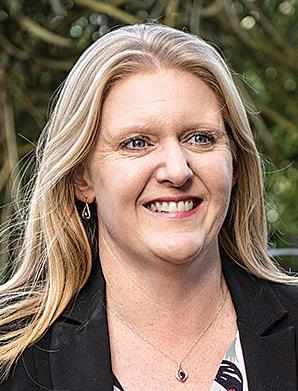

Anna and the team are land development experts and can help with all your resource consent needs around the farm.
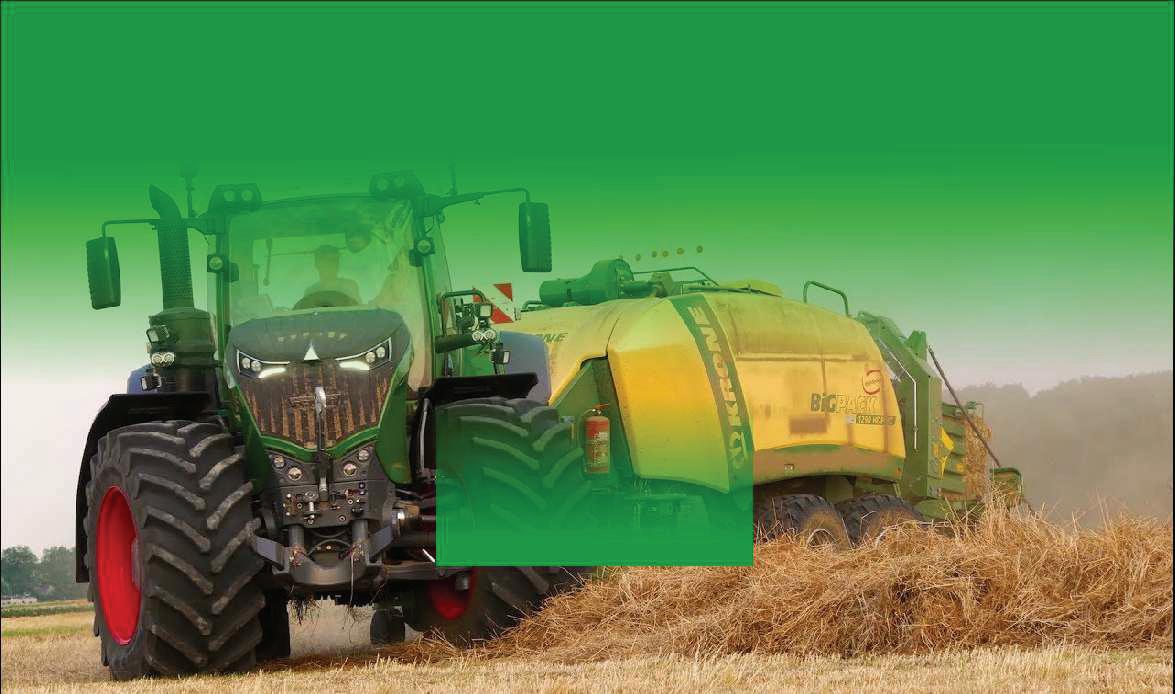
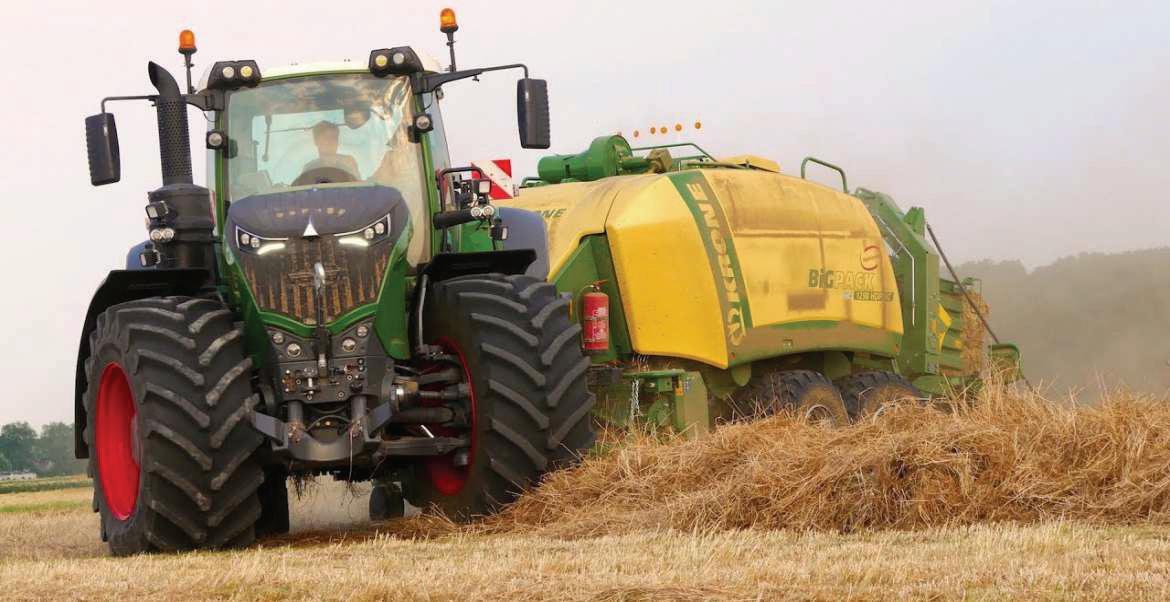
Get in touch about your next project, and with their experience and expert knowledge they’ll save you time and unnecessary cost in preparing your resource consent, giving it the best chance of being approved without delays
SUBDIVISIONS AND BOUNDARY ADJUSTMENTS
WATER PERMITS
SEPTIC TANK DISCHARGES
EARTHWORKS CONSENTS
If you own a residential property or have plans to buy one, it’s important to have a basic understanding of the brightline test (and how it affects you).
In March 2021 the bright-line test period was extended to 10 years for property acquired on or after 27 March 2021.
The bright-line test applies only to residential property. If the property is purchased on or after 27 March 2021, and you sell it within 10 years, the bright-line test will apply to the sale and any profit made will be taxable (unless an exemption applies, as highlighted below).

Exemptions: 1. Sale of the main family home 2. Transfer of property to executors of an estate 3. Relationship property transfers (property being transferred after a separation) The main home exemption can be used if the property was your main home for the entire time it was owned. Where the property is not used as your main for one or more periods of a year or more, while you own it, you will be required to pay tax on
a proportion of the increase in the value of the property that matches the proportion of time that you owned the property and (for 366 or more consecutive days) were not living in the home as your main home.
The main home exemption can only be used twice in a 2 year period. This is to prevent an exemption applying for those who have a pattern of buying and selling a main home.
New build properties are subject to a five year bright-line rule. This new build test will not be able to be used if the property is sold as a bare land section, or if you purchased the property more than 12 months after a code of compliance certificate issued for the property.
Any profit from a gain in property value is considered taxable income. It is important to obtain tax advice if you are planning on changing the “use” of your property.
This book, an introduction to New Zealand’s fish and shellfish, is a “must” for the keen saltwater angler and “boatie”. The authorbestselling author of “The Meaning of Trees” works in Auckland Museum’s Natural Science department. He writes that the oceans of New Zealand “are full of wonder, magic, mystery and awe. Hidden beneath the waves are some of the most

fascinating and unique creatures in New Zealand, all with remarkable stories to tell.” And author Robert Vennell tells the stories in a style that warmly engages with the reader. Informative text with frequent fascinating insights, excellent artwork and photographs and superb design and layout by the publisher make this an impressive and very highly recommended book. A top catch!
For example, if you plan to use your property for something other than your main home for more than 12 months. Moreover, the bright-line test also catches parents who are helping children into their first home, and the bank requires a parent to be a co-owner on the title of the property. If you are unsure whether your property transaction will be caught by bright-line test, or would like more in-depth advice or further inforamtion about the content of this article, please get in touch with the team at Pitt & Moore on 03 548 8349, and ask to speak to Oliver Jones-Allen, Solicitor.
Disclaimer: The information contained in this publication is of a general nature and is not intended as legal advice. It is important that you seek legal advice that is specific to your circumstances.


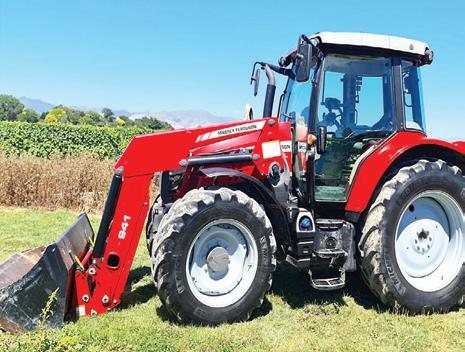

•
245 Power
Forklift very tidy - coming in
Massey Ferguson 4255 105HP stoll loader 4600hrs - in workshop
• Daedong 80hp 4x4 Cab & Loader, very tidy, recon motor - $27,500
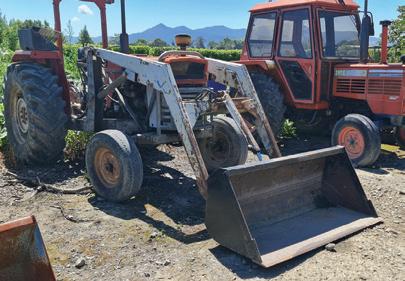
• Iseki 6500 and loader Uro hitch bucket good rubber 4x4 65 70hp good order - $15,000
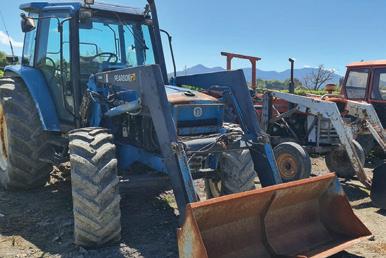
Iseki 2160 22hp hydro in tidy order - $5,750
• Rata vineyard cultivator crumbler range of sizes available
• Dual wheels Snap/locks 38” 36” 34” 30” from - $2,200
11 tyne & 13 tyne grubbers from - $1,500
• Duncan 3m Maxitill very tidy - $2,000
• 9ft Cambridge roller - $1,800
• Trimax 1.8 Vineyard Mower, tidy order - $3,000
• Hydralada double in-row vine trimmer. Fully serviced with joy stick - coming in
• Mole plough good order - $1,850

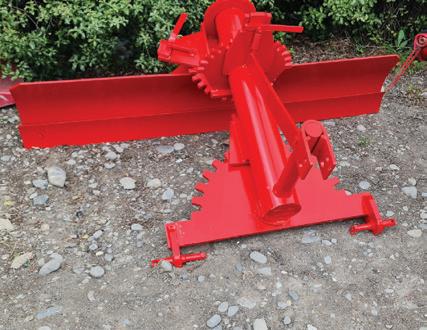
•
- $3,500
• Silvan 600l herbicide sprayer electric controls$5,000
• Celli Tiger 190 Rotary hoe new blade 3m wide cage roller - $9,500

• Hustler SL 700 2 bale feeder very good order$11,500
• Celli Pioneer 170 Spike Rotar very good condition - $12,500
• 3 tonne tipping trailer - coming in
Born and raised in Karitāne, a small rural town north of Dunedin, with a commercial fisherman for a dad, a mum from Ngāi Tahu who worked for the local council, on a family sheep and woodlot farm, was how Bridget Giesen came to love the rural life.
“I helped with lambing, tailing, shearing, hunting and gorse spraying, in fact, a lot of gorse spraying” Bridget reflects. Her parents still live there however Bridget, and her husband Ben along with their three young boys recently moved and now call Teapot Valley in Brightwater home. As a child Bridget wanted to be a horse rider when she got older. “A horse rider was surely what I was going to be until dad asked how I was going to fund this,” smiles Bridget.
Her father suggested that from his own experience of paying lawyers and accountants, that could be a good profession to get into and could fund a horse habit.
Bridget took this advice and went to study law and accounting in Dunedin. After graduation she got a placement in Wellington, far away from the rural lifestyle
which she missed a lot. She relocated to the Auckland office in 2005 when many head offices were leaving Wellington.
Alongside this move, Bridget and Ben, welcomed their first child.
“It was around then that I started feeling that I was a long way from home in the south and with both working in the corporate world, we were missing our connection to the land,” explains Bridget. Together they looked at relocation options and Christchurch, post-quake, and Ngāi Tahu seemed to have a lot to offer.
They both ended up at Ngāi Tahu, Bridget in the investment arm and Ben, who was working for Fonterra, at Ngāi Tahu Farming.
They moved to Canterbury and bought a lifestyle block in Ladbrooks, just out of Lincoln which also meant they were only a fourhour drive from Karitāne.
Ben’s first role with Ngāi Tahu was in Eyrewell, developing forestry blocks into dairy and pastural farms, and then looking at alternative land use. It was this role that caught Bridget’s attention.
“I was fascinated with Ben’s job, I would ask lots questions and we would discuss investment and sustainability, I starting growing

a real interest in all the options for the highest and best land use.”
The next project Ben was involved in for Ngāi Tahu was an orchard trial of stone and pip fruits in Culverden.
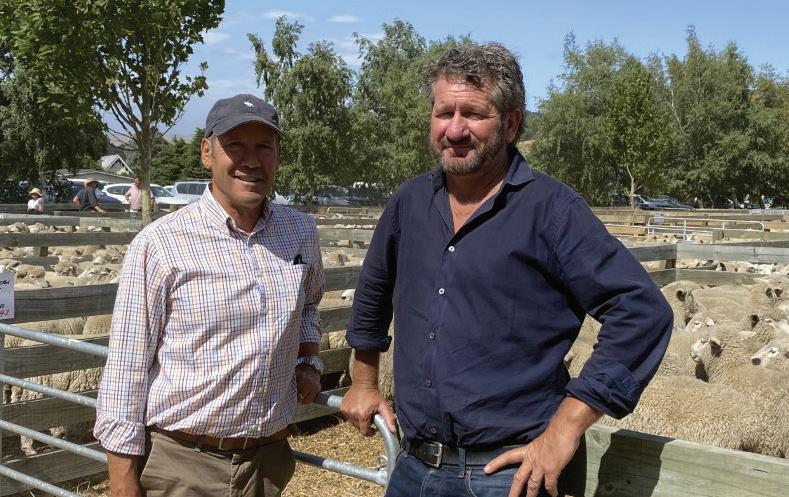
“This brought more interest for me and more questions,” she laughs.

At the same time a few people who they knew in Ngāi Tahu Farming had left and gone into hops.
Not long after, a great friend of Bridget’s dad, George Hill, who had a hop farm in Waimea West, Brightwater, decided to sell and offered the couple the option to buy, hoping they would be interested.
“And we were! Hops lined up with what Ben and I had learnt and we invested along with others in 2018.”
Due to the purchase of land to grow hops at Tea-
pot Valley, the family, now with three young sons and amid the Omicron storm at the start of 2022, moved. “It was really hard when we first arrived, the kids started school with social distancing and mask wearing, it’s hard watching your kids go through the journey of making new friends and finding their place,” explains Bridget. “One thing that does feel really good is that this place had the high possibility of being turned into lifestyle blocks which won’t happen now we are here, it’s nice to see beautiful productive land remain productive. Hops are, in general, kind to the land and environment. This lines up with our values of Kaitiakitanga - caring and protecting land, which was instilled in us while working at an Iwi organisation.” Outside the team effort of running the hop farm, Bridget keeps herself busy with not only being
a mother but an impressive lineup of roles in the agriculture sector. She currently works for New Zealand Trade and Enterprise as customer director manufacturing South Island, which supports exporters and includes subsectors like Agritech, Space, Specialised Manufacturing and Wood Products.

She is one of the five board members for Wool Impact and recently joined the Nelson Regional Development Agency Board. She is grateful for the support she has had in her governance journey. As part of the Ngāi Tahu Future Director programme she was lucky enough to spend 18 months with the Ngāi Tahu Farming Board. And if that isn’t enough, she is about to complete her 12-month term as an associate director on the Pāmu Board as part of their Future Director Programme.
“What has been amazing about Pāmu is that they put farming first and foremost, and with that comes a lot of complexity and high pace of change,” Bridget explains.
She goes on to say that with Pāmu being a large farming organisation they have the collective skillsets to work through some of the big changes and challenges for the good of the agriculture sector. “Pāmu is passionate about the future of food and farming, and they have real leadership with this passion.”
Co-governance has become a major talking point in New Zealand over the last two years, and it will almost certainly continue that way through to the election. National has been open and very clear on our view of co-governance. That is, we do not support the co-governance of New Zealander’s public assets or public services. There are, of course, examples of where co-governance has worked well for specific parts of New Zealand, and they were done in accordance with Article Two of the Treaty of Waitangi. New Zealanders can be justifiably proud that successive governments have delivered fair and equitable treaty settlements, something few if any other nations have managed to do.
National has always been fully supportive of treaty settlements, in fact under the guidance of the Hon. Christopher Finlayson, the last National

Government settled 59 Treaty claims, significantly more than any other. The Three Waters legislation has quite rightly upset many New Zealanders who have seen their water infrastructure assets taken from them.
They have been bundled into one of the four new water entities, and not only have we lost ownership of them but also any meaningful say in their management.
Over many years Kiwis have paid for this infrastructure and now it is being turned over to these mega-entities run by six councillors and six Iwi representatives, who will own and operate the Three Waters infrastructure on behalf of local authorities. Public infrastructure belongs to all New Zealanders, and the management of local assets should stay with local, democratically elected representatives.
The Māori Health Authority
is another example of a divided system, one for those with Māori heritage and another for everyone else. The delivery of public services particularly healthcare should be for everyone and on the basis of need, not ethnicity.
That is not to say that we don’t need to focus on those Māori in need, but we can do that within the one system, with the likes of Whānau Ora and other community providers who can provide a ‘by Māori for Māori’ approach. But a fractured, divided and ultimately separate system that seeks to split New Zealand will inevitably lead to inequities that nobody in the developed world should experience.
There is more that unites us than divides us, and National is committed to better outcomes for each and every New Zealander.
Stuart Smith MP for Kaikōura ElectorateWestgold decided to change its packaging, across all products, to build consumer awareness, as well as differentiating Westgold from other brands. The company want to showcase its quality to both local and international markets. The green pasture backdropped by bush and the majestic Southern Alps, on Graeme McNabb and Rachael Anderson’s 213-hectare dairy farm, is at the end of the road in the Kowhitirangi Valley inland from Hokitika. The picturesque property is where some of the first dairy farms were established on the West Coast because of its flat, fertile land and reliable rainfall.
“Not only is it a lovely part of the country as far as its scenery goes, but we grow great grass here yearround which in turn produces excellent milk,” says McNabb, who moved to the West Coast property five years ago after running a dry stock farm in Canterbury.
“The West Coast is a great place to both farm and live. I wouldn’t want to be anywhere else.”
Westland Milk Products’ general manager sales and marketing, Hamish Yates, says the new look packaging follows two years of research to better understand consumers’ purchase drivers and the trends in food consumption. The design aligns with Westgold’s brand story and reflects its home, Te Tai Poutini, the West Coast of the South Island. “We believe our home, and where we source our milk from, is a key driver for our intense flavours and great quality.
Yates says that as a brand, Westgold is going from strength to
strength globally. “In 2018 we were exporting to 10 countries and by 2022 this had increased to 18 countries. In 2022 we saw volume growth of 58 per cent compared to the year prior. The new look packaging follows two years of research to better understand consumers’ purchase drivers and the trends in food consumption. As a result, the first step was a tweak to Westgold’s identity reflected through its marketing collateral, then to tone and manner with the tagline, “Real. Good.”, followed by a new advertising campaign. The packaging, developed over the last two years, is the last piece of the puzzle, Yates says. In addition to the West Coast images, the packaging also features the brand of Garden to Table - the national charity that Westgold supports. Garden to Table, a charitable trust, supports primary and intermediate schools and kura to take learning out of the classroom and into the garden and kitchen.
“Westgold seeks to inspire people to cook healthy, nutritious, and delicious food. Our partnership with Garden to Table gives us an opportunity to spread that message at the same time supporting the charity’s incredible work which is having an impact on the education and health of future generations.”
More than 22,000 children took part in the programme last year, spending more than 30,000 hours learning essential life skills while growing, harvesting, preparing and sharing fresh kai.
Westgold will officially launch its West Coast inspired packaging for its retail and foodservice products in March, but it may be seen on supermarket shelves sooner.
When I rocked up to the DairyNZ discussion group in Westport recently, I got a very warm welcome from the Keoghan clan and soon found myself at ease in the light-hearted company of West Coast dairy farmers at their discussion group.

DairyNZ’s Mark Shadwick presented the serious business of the day, opening discussion with questions on how farmers are handling the unexpected dry spell on the coast. However, with the expectation of rain in the following day or so, none appeared worried. The overall response was, ‘the grass is still green’. There were a few concerned faces when it came to the other topic of the day, ‘making a profit while costs are increasing.’
The four standouts being increased costs of fertiliser, up
50+ per cent, fuel 10+ per cent, supplements up 35 per cent and finance!
Mark guided the complex discussion through several scenarios.
How to get the best from current soil status, timing of nitrogen application whilst being flexible around summer dry.
With the uncertainty brought about by rising input costs, the downward pressure on the forecast current $9.50 milk playout.
“DairyNZ is running a series of groups to support farmers to maintain profitability,” Mark said.

Farmers attending contributed on topics about close management of finances, budgeting and planning to limit costs. Mark encouraged farmers to control those things they can control.
“Ensure you have a feed management plan.”
Plus he explained the merits of bench marking their operation through the Dairy-base system.
The following day Roger and Jean Gibson hosted the Karamea discussion group.

First up the group looked at cows feeding on his maize crop. The group discussed feed allocation, best utilisation, and overall management tips. When asked if he would grow the crop again, Roger’s response was, “Definitely.” Discussion about managing costs and making a profit highlighted freight in and out of Karamea as a big cost hike for business there.
The following discussion also covered the merits of the NZ grass-based system and when bringing in supplements or using nitrogen can best maintain that profit and be a buffer to manage summer dry or other weather-related risks.
Suppliers of all grades of industrial and household coal
• West Coast sub-bituminous coal with low ash, low sulphur and clean burning qualities
• High grade West Coast bituminous low ash coal

• Premium grades available for your boiler or multi fuel burner
• Bagged coal from 20kg to 1 tonne
• Bulk deliveries
• Coal storage in the Canterbury region for continuity of supply

Give Mark a call on 027 531 0998 for a competitive price to have your coal delivered direct from our mines to your place.
Phone 0800 110 602 Email mark@birchfieldcoal.co.nz www.birchfieldcoal.co.nz

The beginning of this year has been a nightmare for farmers, growers and all who live and work in the northern and eastern parts of the North Island. Cyclone Gabrielle has proved to be every bit as bad as forecasters warned, if not worse.
Having been through our own floods here over the years, which by comparison appear to be trivial, my heart goes out to them as they work through the devastation, hour by hour, day by day.
As we head into 2023 every indication is that it’ll be a bumpy one for us in Golden Bay too. We have hardly begun, and apart from the devastating storms that battered the north, droughts threatening the south and the West Coast, we also have a new Prime Minister with his view firmly on October’s election. Just how big a broom he’ll wield and how that will affect farming in general is yet to be seen. There is the proliferation of the Fall Army Worm to add to biosecurity and infectious disease concerns, Fonterra’s upping the ante on bobbie calves and climate change still to pin down. Environmentally, there’s our very own Water Conservation Order for Te Waikorupupu Springs amongst other issues.
On the other side of the ledger we
need to acknowledge the exceptional growing season we here in Golden Bay are experiencing. While it’s not been the easiest for haymaking, it is fantastic to see stacks of stored feed, green paddocks and stock in good nick. Without being in this ‘sweet spot’ it would have been very dismal as there has been a rapid fall in lamb prices and the general inflation pressures continue. All we need to do now is to keep ahead of parasites, flies and facial eczema!
Also on the positive side, we have had good feedback from Tasman District Council (TDC) following our pre-Christmas meeting to discuss issues around the new Tasman Environmental Plan they are developing. TDC policy staff want to set up more regular (possibly quarterly) informal meetings with us to keep abreast of issues and to air concerns. Nobody else knows farming like a farmer!
Keep an eye out for the Rural Support Trust organised information day with TDC staff. They hope to run it along similar lines to last year’s, where, after short introductions from planners, policy and environment staff, there is opportunity to discuss specific issues with the staff.
For all land development, cultivation, direct drilling, re-gassing, mulching, maize planting, apple tree planter, round and medium square hay and baleage sales and production


Mark: 021 454 000
It was great to have Tasman Valley Young Farmer’s chair, Blair Anglesey, at a recent meeting and hear about the club’s success. It has been absent from Tasman for some time, but is now back, gathering momentum with currently 13 members, on par with other South Island clubs.
One future food production issue that challenges the sector is aging farmers whose replacements do not understand how their career is directly related to our economy, or the big impact they can make on future food production.
One of the best investments we can make into the sector’s future is supporting and encouraging our young farmers and growers.
So Federated Farmers and the Young Farmers Club have always worked together to help aid a successful and efficient path ahead for the future of food and farming. The Club welcomes more members.
A hot topic at the meeting was the sudden change in Prime Minister, and President Stephen Todd stated that the change may be a chance to get some of the unworkable regulations coming out from Government changed or removed.
Brian Dineen, Dairy chair, spoke of continued challenges from the significant flooding event last year.
The Fall Armyworms recently detected in Hokitika was discussed. Many local dairy farmers have small maize crops so everyone needs to be on the lookout as moths can travel 100km per night and easily make it to our area.
More information is on the MPI website, including identification and reporting findings, and MPI have emphasised there are no negative consequences to growers for reporting, as this pest will not be controlled by removing crops.
better than forecast volume was driven by heavyweight retailer promotional and price activity.
The focus across the European Union, UK and North America now switches to Easter, another critical period for lamb consumption. Mutton remains a key market in China, and like lamb, consumption is similarly affected.
Market diversification remains a priority and is essential to maintain product form flexibility with a good mix of commodity cuts and further processed products to maximise sales opportunities.
Meat and Fibre sector chair
Kerry Irvine stated that the sector is struggling with farming costs up and returns down. Beef and lamb demand and pricing has been heavily impacted by ongoing Covid-19 lockdown restrictions in China, our largest market by volume and value.
Farmers have been encouraged by their improved ability to get sheep and beef to the works after a challenging December trying to get space for ewes as spring lambs were prioritised. With many challenges facing the rural sector, Feds continues to advocate and push for workable regulations that benefit all in the sector, not just their members. It can be a lonely, hard and long job trying to work with local councils and a majority government who continue to increase the paper work and rules coming at us. We thank all of those who support the work Feds does on your behalf.
Email: mark.carey@xtra.co.nz
Nelson Dental Centre in the heart stop for general dentistry and oral digital technology to provide the highest quality of care and experience for your dental needs

We are seeing al p non-vaccinated Serving the community and keeping all patients and staff safe during this current outbreak of covid-19.
Nelson Dental Centre in the heart of the city is your onestop for general dentistry and oral health services, using digital technology to provide the highest quality of care and experience for your dental needs.
Meet your professional care providers:
Nelson Dental Centre in the heart of the city is your one stop for general dentistry and oral health services using digital technology to provide the highest quality of care and experience for your dental needs
In particular, balage wrap from lost feed from a number of farms is continuing as a major problem on river banks and in the river. He has been working with TDC, Fonterra, RST and The Rata Foundation on clean-ups and preventing a repetition; a group of volunteers has also been assisting with collecting the wrap. Brian urges farmers to look at bale storage options for more suitable locations on their properties.
Despite recently relaxed restrictions, a significant uncertainty remains, closely monitored by the sector Board. Global inflation and rising interest rate continues to erode consumer confidence around lamb, reducing retail and food service consumption and impacting pricing in our key markets.
Recent information from the key UK market suggests good Christmas lamb legs sales so the supply chain is not overloaded with inventory. The
The vital Province Support Person role is soon to be vacant. This paid administrative role has flexible time needs around seven hours per month. Suitable applicants need to be confident in Word and minute taking. If you, or someone you know are interested, please contact Eloise on 020 4184 2546
Next meeting, which all are welcome to attend, members and non-members, is on 14 March @7pm via Zoom, if you require a link for this meeting please email: nelsonfedfarm@ gmail.com
Dentists: Janette Wilcox, Amy Langfield, Pierre Gill
Meet your professional care providers:
Dentists: Janette Wilcox, Amy Langfield & Pierre Gill

We are seeing all patients vaccinated and non-vaccinated Serving the community and keeping all patients and staff safe during this current outbreak of covid-19
Hygienists: Deborah Pratt & Vikki Neilson



Meet your professional care providers:

STAFF REPORTER
Hygienists: Deborah Pratt & Vikki Neilson along with the friendly support team of dental assistants, practice manager and reception caring for your dental health and well-being
Along with the friendly support team of dental assistants, practice manager and receptionists caring for your dental health and well-being.
Dentists: Janette Wilcox, Amy Langfield, Pierre Gill
Hygienists: Deborah Pratt & Vikki Neilson along with the friendly support team of dental assistants, practice manager and reception caring for your dental health and well-being
Turners and Growers’ (T&G) 194 ha orchard based in Riwaka has been purchased by the New Zealand Superannuation Fund through its rural investment manager, FarmRight.
T&G continue to operate the orchard until the 31 May, 2023, when FarmRight will take over full operations of the orchard and the permanent workers will join the FarmRight team.
The property currently has
33 ha planted in the premium apple variety ‘Envy’ and New Zealand Superannuation Fund have indicated that they have plans to plant more ‘Envy’ apples to help meet the growing demand around the world for the ‘Envy’ apple variety.
One of the best investments we can make into the sector’s future is supporting and encouraging our young farmers and growers
Paddocks lined with potatoes used to be a common sight when coming through Kohatu and Tapawera, now days it’s a sea of green with rows and rows of hops, so where have all the potatoes gone?
“The job of growing spuds just got too difficult,” explains Peter Phillips, ex commercial grower of potatoes in Tapawera. “Many different things made spud growing uneconomical, which is a shame as we have the perfect potato growing conditions here.” Tapawera has a great climate for potato growing and due to the Motueka River mineral belt the soil is rich in magnesium, which potatoes love, but there are no commercial growers in Tapawera anymore, there is the odd small patch here and there but none more than half an acre large.
“Years ago, we kind of had Nelson and Tasman to ourselves but that changed. We now have produce liners who take produce from Nelson to Christchurch daily so to make this trip more profitable they looked for something to bring back, which was potatoes,” says Peter.
This made the transport cheap which enabled a low consumer price as well as offering consumers more variety. “Consumer price is the main driving factor, and we couldn’t compete with large farms on the flat in Canterbury, so the big growers have gotten bigger, and the smaller ones have dropped out.
“The bigger growers work on very low margins and good returns; us smaller growers were working on low margins but just didn’t have the volume, so it wasn’t profitable. We just don’t have big enough areas of land to get the volume needed.”
Another factor that increased the difficulty around growing potatoes profitably was the cost of machinery.
Machinery costs are eye-watering and big-ticket items like a potato harvester is expensive to maintain, being a high-wear item from being used in the ground all the time. “You have to have the machines, no one out there is willing to hand pick potatoes these days,” Peter adds. Other machinery required for potato farming includes a tractor, grader, bin tipper and spray equipment. Machinery needs to be in good condition and main-
tained regularly as potatoes are a heavy item around 20 tonne a hectare and a bin of potatoes weighs around .75tonne. All this creates expense.

A small insect, similar to the size of an aphid, called Psyllids played its part in disturbing potato farming in the Tapawera region. The insect breeds all year round, lives off nutrients in plants leaves and favours the underside of leaves. The pest causes damage to the plant and the quality of the potato.
“To control the Psyllids, you get an expensive spray that
absorbs into the plant, when the bug sucks the plant, it sucks up the spray.” Peter explains that having a detailed spray programme was essential as the bugs can build a resistance to the spray used so a variety of different sprays are required to be effective.
“Spraying is a real balancing act; you don’t want to kill off the beneficials such as lady bugs which eat the Psyllids and other insects”.
Peter hasn’t grown a potato for five years but acknowledges that they are a billion-dollar industry. Despite no potatoes being grown in Tapawera, production in New Zealand over the last 10 years has increased. There are over 200 potato growers, and the growing area is 10,591 hectares. Around 525,000 tonnes of potatoes are grown annually. If the average size of a potato is 175g, this is approximately 3 billion potatoes. Approximately one quarter of the annual crop is exported.
Dataform 2021 has shown that the overall value of the industry, including export and domestic market, dropped slightly to $1.095 billion. The domestic market dropped slightly to $993,447 in value.
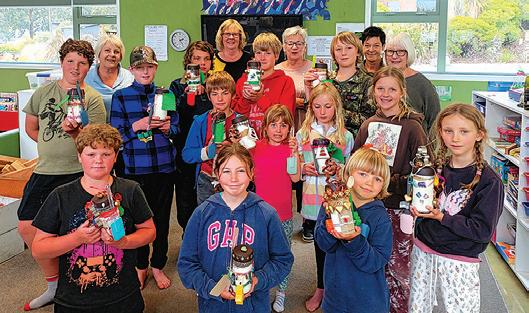
Living rurally about an hour from a major centre can be lonely for young mothers’ reports Marg Anderson of the St Arnaud Rural Women. Especially if they are new to the area and are having babies and there is nothing already happening, they can join.
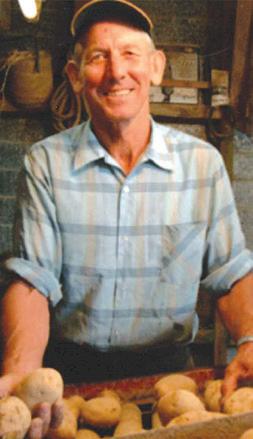

“When our branch noticed there were a number of young mothers in the area, we decided the best way to support them was to start a young mothers’ group,” reports Marg. She says, Initially, everyone was a bit shy but now two years on the group has eleven young mothers coming along and the young women have taken the lead, becoming a regular weekly play group. The Mums and children meet at the local
Golden Bay Rural Service Centre manager, Jeff Riordan reports that farmers in Golden Bay are generally well off for feed this summer. However, he says the humid weather of late January and early February could have a lasting affect as pasture spore counts have put the area on high alert for Facial Eczema.”
Jeff says in December, the Rural Service Centre ran a promotion which attracted around 70 farmers to learn about the Facial Eczema problem. The Service Centre brought scientist Dr Emma Cuttance to Golden Bay to share her extensive knowledge about the disease and the impact of fungal toxins on the liver of cows. Emma warned farmers that surveys have highlighted one third of cows in Faecal Eczema prone areas will suffer significant liver damage. Eighteen degrees, overcast and drizzling is the perfect temperature and conditions for fungus to grow and produce spores in grass litter at the base of a grass sward. Cows eating spores might look OK, but they will have liver damage which will affect milk production. “Prevention is the best approach,” Emma says. Farmers can get spore counts done by by their vet. Its best to get 3-4 paddocks tested to define which paddocks are a problem as there is wide variation between paddocks and farms in the same area. She says a fungicide spray is one approach, but to remember it only works on fungus, and it won’t kill spores. She recommends to only apply fungicide on pasture with a very low spore count. Another option is zinc but often cows don’t get the right dose. The dose needs to be accurate in relation to the weight of the animal which is difficult to work out unless you can weigh each animal. Capsules are another option. but they are costly therefore spore counts are essential for evaluating what your best prevention methods are. As result of learning about the disease, a number of Golden Bay farmers have returned pasture samples to the Rural Service Centre with spore counts as high as 60,000.
hall and ladies from Rural Women take turns at going along to support them.
“The whole experience has been heart-warming. We get to cuddle those lovely new-born babies.” Lasting friendships are formed with them as they grow. “Being a regular part of their lives and seeing these small people develop and learn is very
special,” Marg said. The branch has been able to get a retired Kindergarten teacher along to give the young Mum’s ideas. She came for 5-6 weeks to support the mothers and children with play ideas. The group have requested she comes back for another stint as the children have grown and need further extension for their
development. Rural Women also arranged for a St Johns trainer to run a First Aid course while they babysat the children. Marg said, “the children could see their mothers through the glass doors and consequently there were toddlers demanding to get to their Mums” she laughs. “Distracting toddlers and babies wasn’t very successful. We all learned from that.” At Christmas St Arnaud Rural Women put on a morning tea for the parents and children, with a surprise visit from Father Christmas in the Fire Truck (thanks to the Local Brigade,) with each child receiving a book. “This has been a successful way for young women to meet up and support each other through the early childhood years which are a big adjustment for everyone.
MPI is backing a new Marlborough-based study to evaluate how hardwood forests could boost sustainability and reduce greenhouse gas emissions in the region’s wine industry.
MPI’s director of investment programmes, Steve Penno, says hardwood eucalypt forests could provide an important alternative land-use in the region, and natural carbon storage options.
“The study, led by NZ Dryland Forests Initiative (NZDFI) and based at the Marlborough Research Centre (MRC), will evaluate the potential for new eucalypt forests to sustainably supply naturally durable posts, timber and biomass for bioenergy for Marlborough’s wine industry and other local industries,” Steve says. Project manager Paul Millen notes that certain eucalypt species are fast growing, drought tolerant, and produce strong, dense and naturally durable hardwood, which can be used outdoors without chemical treatment.
“Untreated eucalypt timber posts in vineyards can last more than
20 years in the ground without contaminating the soil.


“The eucalypt posts can be reused or recycled afterwards, unlike the treated radiata pine ones used currently, which represents a huge opportunity to enhance environmental outcomes in Marlborough, and is aligned with the objectives of the NZ Wine Centre, also based at the MRC.” NZDFI will receive $262,300 towards the research through the Ministry for Primary Industries’ Sustainable Land Management and Climate Change fund. Marlborough Re-
search Centre Trust will contribute $10,000 and the University of Canterbury’s School of Forestry and four local landowners will provide $115,500 in kind.
“Marlborough landowners have had a tough time in the past year, with the two extremes of droughts and floods hitting the region,” Steve says.
“Planting eucalypt forests on less productive land could provide an alternative land-use option and help the resilience of local landowners. It would also diversify New Zealand’s wood supply for
future generations.” The project will develop models to show biomass accumulation and carbon storage for two key eucalypt species.
It will assess these trees, including using innovative Light Detection and Ranging (LiDAR) drone technology to measure their biomass and carbon storage capabilities. It will also develop a business case to demonstrate how a 5,000-hectare durable eucalypt forest resource in Marlborough could offset emissions.

“Marlborough vineyards alone span more than 30,000 hectares, containing more than 18 million posts predominately made from treated radiata pine,” says Paul.

“Planting eucalypts could boost sequestration, and provide a sustainable regional supply of naturally durable posts and other timber, as well as biomass to supply solid biofuel to the wine sector.
“The project will provide a market and science-based pathway for eucalypt trees that gives confidence to develop this new forestry system in Marlborough.
“It also has potential to generate new investment and jobs in the regional forestry supply chain.”



Steve says NZDFI has identified several regions where eucalypt forests could also be grown successfully.
“The model developed by this new study has the potential to apply to other regions, mostly in the North Island.
“This study will help to pave the way as we transition towards a low emissions future, and if successful, provide important environmental benefits, while helping our rural economies.”

Recently a series of public meetings have been held seeking feedback from Sounds residents on the future of the roading network in the area.

Marlborough District Council strategic planning officer, Neil Henry, told the meeting that it was important to gather information from residents about the problems they faced.
The floods of the previous years has caused major damage to the roading infrastructure. Neil said that the cost of future proofing the roads was too much for council to finance on its own,
so government funds would need to be sought.
“We are not the only region to go through this process and after the recent flood damage in Auckland, Coromandel and the East coast we must put our case as quickly as possible.”
Barbara Faulls, Council representative for the Sounds urged the community to respond to the council survey, explaining the problems they are facing, so that we can present our case to Waka Kotahi and the government.

Engineering consultants Stantec have been employed by the council to investigate the problems and present a business case to

possible funders.
Courtney McCrostie, transport engineer from Stantec said she hoped a solution could be provided that everyone could live with.
She highlighted some of the challenges faced by engineers, such as a lack of alternative routes, increased rainfall from climate change, and unstable geology.
At the meeting attendees were asked to stick up ‘post its’ on maps of their particular area of interest, outlining their concerns and possible solutions.
These, would be collated by those leading the study and presented to government and Waka Kotahi. Concerns were expressed

to Marlborough Roads general manager about the lack of progress on repairs so far. He said the strategy was to prevent further damage being done and to keep business going as far as possible.

One resident expressed concern that restricted access on the Kenepuru was not being enforced. A hunting camera he had erected had recorded 502 vehicle movements on one day during the holiday period. This reduced to 49 once all the tourists had gone home. Many ‘post it’ suggestions included simple things such as keeping the culverts clear. Slips could quickly cut off commu-
nities. One couple residing in Moetapu Bay said the original storm immediately took out the cell phone tower, disrupted the water supply and closed the road. The only access is by sea which is only available at high tide as there is no serviceable jetty. These problems must be magnified several times by the hardship currently being experienced in Hawkes Bay and are indicative of the vast sums of money that needs to be invested in infrastructure throughout the country.
A long-term plan, free of party-political prejudices and ideological fantasies would be a good start.
TONY ORMAN
Federated Farmers is calling on the government to revisit a raft of unworkable regulations and halt even more that are close to completion, as they threaten the viability of farmers and the Marlborough economy.

Speaking to delegates at the February meeting of Marlborough Federated Farmers, Peter Matich, Feds regional policy manager for the Central Region, outlined a number concerns with current and proposed environmental regulations including the “train wreck” that is coming with the poorly-drafted bills proposed to replace the RMA.
Peter Matich described a government “Exposure Draft National Policy Statement on Indigenous Biodiversity 2022,” prepared by the Ministry for the Environment, as worse for farmers than the previous 2019 draft policy on biodiversity.
“It takes away specific recognition for farming as an existing activity,” he explained. “The new protection for Specified Highly Mobile Fauna (birds) would be more intrusive over private land. On the whole, the policy would create more uncertain regulation, more litigation and more costs and delays for farmers.”
Turning to a National Environ-
ment Standards for Sources of Human Drinking Water, Peter described it as heavy-handed and unnecessary.

“Instead, we have asked government officials to provide a riskbased approach to restricting activities and to defer decisions regarding restrictions around drinking water sources to regional councils to decide, in consultation with their communities.
The government’s final decision is still on the drawing board and we await the outcomes of the government’s ‘policy prioritisation exercise’ to see where this goes.”
Proposals for “intensive winter grazing” regulations, although modified in response to Federated Farmers’ suggestions, were still lacking.
“We continue to be unhappy with other aspects, e.g., the definition of ‘annual forage crop’ which should be amended to ensure arable crops are not captured. The latest on this is that the government is now loosening the reins further, to the point where individual regional councils have wide discretion over enforcement of the intensive winter grazing regulations.”
Peter said councils have indicated they would take a ‘risk based’ approach - only enforcing the rules
where farmers are undertaking highly risky practices. This could help in the sense that most farmers would seek to avoid the cost of a resource consent; but unhelpful where farmers are ‘seen’ to be not generally non-compliant (e.g., where a bank or irrigation scheme requires all consents to be up-to-date). Much would also depend on how implementation of the regulations is dealt with by individual council staff. Federated Farmers are monitoring the evolving situation and considering their response.
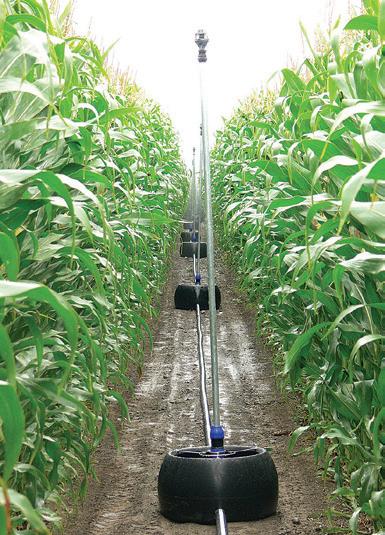
Jointly owned by the Ministry for Primary Industries, the Fertiliser Association of NZ, and AgResearch Ltd, Overseer aims to determine fertiliser application rates on pasture so as to learn more about nutrient loss from farms. However, in late 2021, government released a report on Overseer from an independent Science Advisory Panel which expressed a lack of confidence in Overseer as a tool for assessing nutrient loss.
“Feds has been saying for years that Overseer should not be used as a regulatory tool, so we welcomed these findings,” said Peter Matich. “We are working alongside other Team Ag organ-
isations on alternative approval pathways.”
Referring to local Marlborough issues he said the Marlborough Environment Plan (MEP) has been a significant focus for the district over the past five years.
“The MEP is a single resource management plan for the district that regulates what people can do on their land and how it may be developed into the future, including rules on resource use in areas relating to biodiversity, landscapes, water use and more.”
The council’s decision on the full plan was released in 2020, after nearly two years of rolling hearings, on a topic-by-topic basis with a number of positive changes for farmers as a result of Federated Farmers submissions and hearing evidence.
“However, there were numerous sticking points so we appealed the council’s decision to the Environment Court, featuring 75 appeal points. So far most of FFNZ’s interests in the MEP have been resolved, with mediation continuing into 2023, with topics related to water likely to be the most contentious.”
Marlborough Council is gearing
up for a further review of the Environment Plan - to catch up with the 2020 NPS Freshwater Management - and the first round of new changes is a re-jig of the Freshwater Management Units (‘FMUs’).
“While we support cost effectiveness, we say that FMUs should reflect the communities of interest in different localities. Combining FMUs needs to be done carefully to avoid over-aggregating land uses in the FMUs, to the detriment of farmers when it comes to regulation. Environmental goals should reflect a local community’s ability to manage their activities.
“Top-down rule regimes can be too-easily captured by a narrow scope of political interests, resulting in unrealistic and unattainable goals. We’re evaluating the council’s proposal and think that a series of general ‘question-and-answer’ sessions with council staff for members might provoke some useful feedback for the council,” said Peter Matich.
The Regional Policy Team consists of approximately 20, spread over northern, central and southern sectors with a diverse spread of expertise including scientists, planners and lawyers within the team.
TONY ORMAN
The highly successful open farm day at the Dawkins family farm “The Pyramid” in the Waihopai Valley is on again, on the 12 March starting at 9 am and finishing at 4 pm. Prior to Covid there were two previous open days on “The Pyramid” where the public could visit the farm.
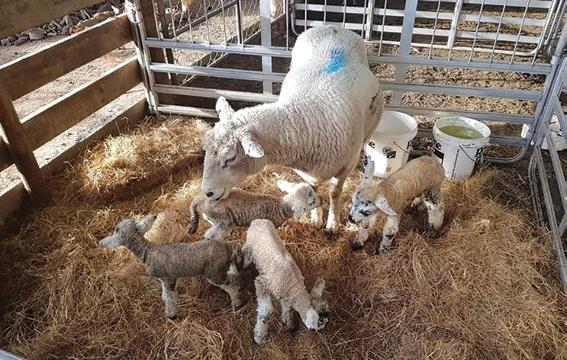
“The days were really well attended,” says Richard Dawkins and added, “So we’re back.” The days are very much focused on town people but alltown or country - are welcome.
“The idea is to give folks who don’t have access to a farm, the opportunity to come out and experience a small taste of rural New Zealand,” explains Richard.
There will be a machinery display, sheep shearing, trail-
er rides behind the tractor around the vineyard, a swim at the river, a farm walking tour and even a chance to try drenching some sheep. Also kune kune pigs, raffles, prizes, kids games bouncy castles and more.
The 602-hectare Pyramid is a three-generation Dawkins
family farm, begun by Jack and Jean in 1954, taken over by Chris in 1978, and now farmed by Chris’ son Richard and Chris under a succession plan.
Richard’s brother Paddy and his wife Laura run Pyramid Apiaries, a business that puts hives on the home farms and
around the district.
Diversified returns from sheep, cattle, forestry, firewood, honey and grapes have facilitated the farming succession plan from Chris and Julia,
to Richard and Jess and their growing family.
“The Pyramid” 256 Avondale Road, Waihopai Valley. Please register on the Open Farms website.
Over Easter weekend past Woodsman Rangers from the Golden Downs Forestry school are meeting for a reunion. The re-union was initially planned for last Easter but due to Covid was delayed until 2023. Organising committee member, Sally Quickfall says, “the delay has allowed word to get around.” To date they have over 130 registrations of former
Rangers and their partners from all around New Zealand and some from Australia and they are expecting more before registrations close. “It’s going to be a wonderful reunion.” Predicts organising committee member Chris Bensemann, who was in the 1975, Ranger intake “when these men reconnect in a social setting once again, tongues will be wagging.”
The Golden Downs, Woodsman Training School (GDWTS) was set up in 1951 and ran till 1982 when the School at Tapawera closed. The school was set up to train young men between the ages of sixteen and eighteen to become skilled at all facets of Forestry and those young men went on to be leaders in the forestry industry and associated industries. Some went on to set up their own logging companies and private corporations once the Forestry Service closed down. The school itself had a hostel with a communal
cookhouse presided over by cooks for trainees and a matron to care for the young men who had often just left home. The original GDWTS was, set up in Golden Downs moving to Tapawera about 1975.The Ranger course was held over two years of training, plus one year working in another forest. Students lived as part of a community in the village and developed enduring friendships. The
camaraderie and fellowship of those years is a bonding memory for many, Sally says. She was brought up in Golden Downs too and went on to train as a Forest Ranger. The reunion begins on Good Friday with a social get together, Saturday is a to Golden Downs Forest, the old village site at Tapawera where the newer camp was, and a visit to the Higgins Park followed by a dinner, for-
The
advise and management
• Forest Valuation
• TFM are part of the Forest Management Group with offices throughout the South Island, Hawkes Bay and Southern North Island

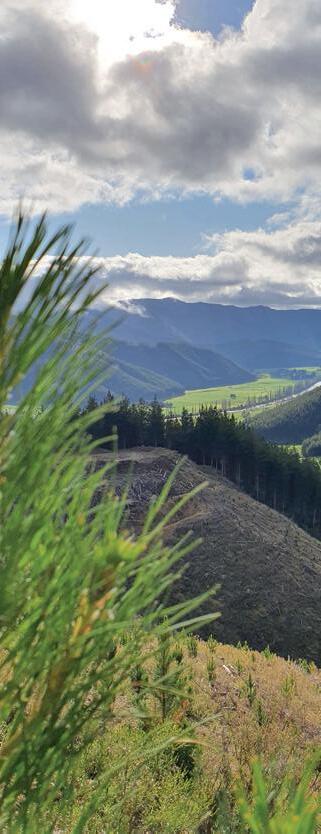
mal talks with music by the Gypsy Pickers from Golden Bay in the evening. On the Sunday, there will be guest speakers, talking about modern Forestry and the technical advances.
For further information email gdwtsreunion@gmail. com and check out the Facebook page for ex Woodsman and their families at Golden Downs Woodsman Training School Reunion 2023.
The
PF Olsen is the leading provider of independent professional forestry services in New Zealand.




PF
PF Olsen is the leading provider of independent professional forestry services in New Zealand. Contact us now for all your forest

•
• Forest establishment and tending
• Forest valuations
• Due diligence on forest purchases/sales

Murray Behrent’s message to farmers at a recent Beef and Lamb Field Day at Alliance Meats in Nelson was that “tweaking your business” will result in more money in farmers pockets.

Murray is the Group Manager at Alliance and he outlined the criteria that lamb producers can meet in order to achieve up to $21/per head over schedule for their lambs.
He illustrated his point by showing attendees a typical kill sheet of 500 lambs of which 359 achieved a $9 premium over the threshold payment.
“There is a great variation of product in our grass-fed freerange systems and our aim is to maintain a consistency in our product line. The focus for breeders is from the loin to the muscling in the rear quarter, this is where the money is made. When you go to visit your ram breeder this is the area you need to concentrate on. The more meat yields the more dollars. Our ideal lamb is from 14.5kg to 23 kgs with a fat layer between 5 to 9mm. Farmers have made good genetic progress in recent years going from 51% yield in 2000 up to 55% today.”
Ewe or wether lambs are required by customers nowadays
as we have had negative feedback on the taste of ram lambs particularly after the month of March.
A quick turnover lamb weighing 18kgs finished by February/ March is ideal for the producer as yields tend to drop off thereafter particularly if dry weather sets in.
Fewer stock numbers will also assist farmers in drought conditions. To maintain an acceptable PH, it is recommended that stock are loaded in an empty condition and that no dogs are involved. It has been found that it makes very little difference to the PH as to the length of journey if they have been loaded under those conditions.

Plant Manager Stephen Baird outlined several conditions that would result in product being downgraded as it passed through the plant.
Delays in processing would result if the NAIT paperwork is incorrectly filled out. Sheep should be in clean condition round the rear end as contamination of the meat could result. Care needs to be taken with vaccinations as infection could occur with poor techniques, and result in areas of the carcass being discarded.
Dog bites and bruising caused by poorly maintained yards should be avoided. Seed contamination of the carcass would
also result in penalties as well as unnecessary suffering to the animal.
Sheep measles is another problem that has been observed particularly in sheep that have been grazed in worm infested vineyards.
Faceal eczema will also affect liver quality. From the first of October to the 31st December it is important to mouth sheep for age classification. Do not send a mixed age line of animals, split them into two lines to save time at the plant.
The Alliance Group has plants throughout the country. It is a farmer owned cooperative with 5,000 members and employs 4480 employees.
It is the largest sheep meat exporter in New Zealand, processing 57 million animals per annum. It exports to 65 countries offering 1200 different products. The Nelson plant employs 240 people and has been in the area since 1908 putting $82 million into the local economy.
Forty international workers are currently going through the visa process with a further 14 due in March.
Stephen says they are urgently looking for staff so that the plant can be run to capacity. Full training will be given on site to anyone looking for employment.
modest increases as limited evidence of renewed interest from Chinese mills became apparent, although not all traditional types were targeted.
Prior to February 13, there had been an expectation that coarse wool prices may improve slightly given the on-going wet weather experienced across much of the North Island, resulting in shearing and transport interruptions hence lesser wool volumes filtering through to market. We all know what events have occurred across wide areas of the North Island since that time, and our thoughts go out to all people who have had their futures re-mapped as a result.
As eluded wool auctions held in both Napier and Christchurch in early February had recorded very
A South Island only auction on February 16 however brought a much more urgent response from exporters, several of whom had scoured wool stocks ready for shipping off shore as well as greasy wool stocks ready to be scoured with significant volumes possibly suffering from the severe flooding event which engulfed one wool scouring facility. Consequently, market prices for most coarse wool types improved by between six and twelve percent in the Christchurch auction room, compared to prices ruling a week earlier, as exporters tried to cover their forward sold positions. Most interest was shown
Beef + Lamb New Zealand, promoting the red meat sector’s manifesto. The manifesto, which was launched last week, spans five key areas – climate and environment policy, workforce and industrial relations, trade, biosecurity and innovation, and research and development.
Our media release on the proposed policy changes received considerable coverage in both mainstream and rural media.
“The high level of mainstream media coverage provides us with the platform to reach a much wider audience,” says B+LNZ chief executive, Sam McIvor.
“It’s critical that the general public understand the raft of changes proposed by the government will negatively impact every New Zealander through reduced export revenue, increased food costs, and lower farmer spending, which underpins rural communities.”
Sam and chairman Andrew Morrison voiced the sector’s concerns on the AM Show, Newstalk ZB and RNZ Morning Report. Meanwhile, B+LNZ’s manifesto social media posts generated significant interest (more than 10,000 impressions). The manifesto has been sent to every Member of Parliament and all relevant officials as farmers face an overwhelming wave of environment-related policy proposals and regulatory changes.
“Our message is clear – farmers are committed to playing their
part, but the government has tried to do too much, too quickly,” Sam says. “The speed, scale, impracticality, and disconnectedness of these rules has been unreasonable, and understandably overwhelmed many farmers. No other sector is facing the level of change that we are.”
B+LNZ and the Meat Industry Association are urgently calling on the government to curb the sale of sheep and beef farms into carbon farming and for methane targets to be amended in line with the latest science.
“We’re also strongly urging the government to pause the National Policy Statement for Indigenous Biodiversity and narrow the definition of Significant Natural Areas (SNA). The current NPS and definition actually disincentivises biodiversity protection,” he says. McIvor says it is important to New Zealand that the red meat sector performs well as it generates more than $12 billion in income annually and supports 92,000 jobs (4.7 percent of total national employment). Farmers also support their communities with approximately $100m of farm-related expenditure every week.
“Our sector has a proud and proven record of lifting our productivity and profitability while at the same time improving our environmental footprint, but pragmatic policy and regulatory settings are critical and we’ll keep pushing the government on this,” he says.
for well-prepared second-shear types measuring from 35 to 38 microns, of very good colour and little or no vegetable matter contamination, plus well skirted lamb’s wool types, preferably finer than 31 microns, of very good colour and 0.0 percent vegetable matter contamination.
Having said that however, and with the current season delivering poorer colour full length fleece wool than desired due to the warm, humid conditions experienced, being no fault of growers, average to good colour fleece wools also drew good support with increases in price of between six and eight percent compared to the week earlier.
Mid micron wool types representing the corriedale and halfbred breeds continued to struggle, with only limited interest
from exporters directed mainly towards finer than approximately 26 micron types of good colour, good staple length, and low vegetable matter contamination measurements. A few lines of similarly bred lambs’ wool in the 22 to 23 micron ranges drew very good support from exporters who obviously had specific, but limited quantity, orders to fill.
The February 16 South Island auction was also the designated wash-up date for any current season merino wool types which had either missed the main fine wool selling dates prior to December, or had been passed-in at earlier auctions failing to reach growers reserve prices, and approximately 500 bales were catalogued. Some very stylish wools, measuring from approximately 15 through to 19 microns, com-
manded strong interest from the full bench of exporters present, with the vast majority of bales either sold from the auctioneers rostrum at the fall of the hammer, or negotiated after the sale has concluded.
Prices were reflective of recent Australian based wool broker auctions held in Melbourne, Sydney, and Fremantle.
As a result of the recent floods and devastation in the north, which also seriously affected a major wool scouring facility, there will no doubt be considerable wool pipeline disruption however, from the south’s perspective, at this point the next Christchurch based wool auctions, scheduled for March 2nd, 9th, 16th and 30th are more than likely to proceed as usual. That’s my view.
 JOHN BARNES Managing Director Fertilizer New Zealand
JOHN BARNES Managing Director Fertilizer New Zealand


The symbiotic relationship between plants and soil are seamless when everything is in balance. But sometimes nutrient deficiencies occur, which can restrict plant development and specifically root development. When the growth of a root system is restricted, it can remain in poor condition, unable to draw the required nutrients applied to the soil. This means the plant will likely perform poorly or fail, especially in adverse environmental conditions. The impact of this can be severe, and at times our survival is riding on the success of each and every plant. What options are there to improve plant performance when it can’t access optimum nutrients through the root system? Applying a foliar fertilizer rectifies plant nutrient deficiencies rapidly. It is an efficient method of feeding the plant because the nutrients are rapidly absorbed through the plant leaf. It proceeds to balance plant nutrient levels and feed the entire plant without being reliant on the quality of the root system. Rapidly restoring the overall health and performance of the plant.
Actavize® from Fertilizer New Zealand is a good solution as it has 15 different elements and includes trace elements that promote growth. It is not just a case
of supplying the tree/vine with the typical nitrogen, phosphates, potash and sulfur nutrients. It is also about supplying a vast array of other elements which are vital for plant health, in a way that they can be utilised. This means the ratio of elements provided should be correct, much the same as we need nutrients and elements in the correct ratio for ourselves.
The time to apply this to fruit tress is in Autumn, between harvest and leaf fall. Once the fruit has been harvested, the fruiting buds for the next harvest are already forming and the plant is looking for more elements and nutrients to replace what has been utilised by this year’s crop. For some fruiting trees and vines which are mainly deciduous, the roots never rest even though there is seemingly nothing happening with the tree above the ground. A lot is happening in the root system. It is getting ready for Spring. So how can we assist a fruiting tree or vine in the case of grapes, in rebuilding their nutrients for Spring? Applying Actavize to the leaf will then give the plant many more balanced nutrients which it will then take down into its root system and store for Springtime when it needs the energy to grow new leaves and produce fruit.
To find out more about how this works, give Fertilizer New Zealand a call on 0800 337 869 or visit www.fertnz.co.nz

It’s easy to fixate on detail and become embroiled in meaningless debate. I’ve been at discussion groups when people wanted to claim that an Olsen P level of 25 was better than one of 15, or the ideal soil pH is 6.3 rather than 5.9. Any soil test number is meaningless until put into context. There’s a large amount of extra information required before any single measure is worth spending thinking time on. Fertiliser costs money and of late it’s become increasingly expensive, a situation that is unlikely to change this autumn, therefore it’s essential to know what the aim of applying fertiliser is. In the short term, if there’s not available money, or it can be put to better use, sitting tight might be the best option.
Where fertiliser has been regularly applied phosphorus inputs will almost certainly be higher than maintenance and not applying this autumn is unlikely to limit production over winter and spring. Potassium falls into the same category. Plant availability of potassium when soils are sufficiently moist for maximum growth is likely to be adequate over autumn, winter and early spring. It’s not so clear-cut with sulphur, particularly in the South Island on low ASC soils, typical of all but volcanic soils. Under heavy rain plant-available sul-
phur can leach rapidly, and unless elemental sulphur has been regularly applied, a growth-limiting sulphur deficiency could occur in spring.
Withholding nutrient inputs for longer is likely to be false economy with the cost of lost production greater than the money saved. As fundamental to optimum growth as the nutrient status of the soil, is the rate at which nutrient is being cycled.
Early research identified and much has been written on the factors that influence the Rapid
essential that there is a sufficient interval between grazings for soil to regain their optimum structure.
In periods of excess rain animals will cause damage, it’s inevitable, with the only choice being whether the mess is confined to a small area that can be sorted at a later date or creating a lesser problem over a larger area. Spreading animals out means the damage is less obvious and natural recovery will follow, however there will be some impact on future growth during that time. The other is ensuring sufficient calcium to maximise beneficial fungi, bacteria, and earthworm activity.
Organic Cycle (ROC). Essentially, it’s the speed at which nutrient from unavailable sites becomes available for plant uptake that’s important, which in turn is reliant on the activity of beneficial biology. Depending on which nutrient is the focus, as little as one per cent is plant available and seldom more than five per cent at any point in time. There are two factors that have a major impact on nutrient cycling that farmers can influence.
One is physical soil structures. Ideally soil should contain 25 per cent air and to achieve that it is
Functional Fertiliser makes CalciZest, a product proven over 25 years to stimulate soil biology, increase clover growth and improve physical soil conditions. Due to the inclusion of a wide range of beneficial soil microbes the response is rapid, with a greening in pasture often obvious within three weeks of application provided there’s sufficient moisture for strong growth. It is the release of nutrient from dung, old root, and leaf on the soil surface that provides the nutrients, including nitrogen, for strong autumn growth.
After a summer dry spell beneficial soil biology is at a low ebb, and by applying calcium along with immediately active beneficial soil microbes an increase in the speed of pasture recovery is guaranteed.

For more information call Peter on 0800 843 809.

In periods of excess rain animals will cause damage, it’s inevitable
Peter Burton


HortNZ
Our thoughts are with all the people and growers across New Zealand who have been affected by the latest atrocious weather event, Cyclone Gabrielle. From what I have seen and heard, the impact has been devastating and it will take years for areas of the Hawkes Bay and Gisborne to recover.
It is however too soon to talk about recovery when people have lost their lives or are missing. I know of growers who immediately dropped everything and used resources like helicopters and tractors to rescue people. Some of these same growers have also lost everything – their crops, machinery, houses and cars. Our thoughts are with
all the growers, RSE workers, families and communities that have been affected by Cyclone Gabrielle, which has proved to be more damaging than Cyclone Bola in 1988.
A group of primary sector leaders got together last night to develop a plan to take to government to address affected communities’ immediate needs, as well as the sector’s long-term recovery. But for now, the focus needs to be on ensuring everyone is all right – physically as well as mentally. Growers are resilient but there are limits. Please don’t test those limits. Instead, please follow Civil Defence’s instructions and
stay safe. Where you need help, reach out as best you can to others in your community who may be able to help. Part of the plan we are taking to government is to ensure support services are not overloaded, in what will be a long recovery. Please also remember that HortNZ and product groups are here to help. Please contact us or your product group directly, but if you are unsure who to contact, please email info@hortnz.co.nz.
Cyclone Gabrielle has come at the time when submissions on the acts to replace the Resource



Grape growers in Marlborough will be feeling lucky having dodged the effects of cyclone Gabrielle. PGG Wrightson’s representative in Blenheim, Blair Mclean, says reports from the Hawkes Bay area in particular sound pretty devastating. Vineyards are under water and wineries have been flooded. The PGG Wrightson’s store has also had water throughout. “There will be vineyards that have not been flooded, but those that have are unlikely to salvage any of the harvest this year.”
Blair is also a cherry grower and says that wet weather in spring also badly affected the cherry crop in Hawkes Bay this season. In his own orchard they experienced a cold wet spring and a little frost damage which restricted the crop to about 60% of normal. However, a percentage of the trees were covered and they produced top quality fruit that attracted good prices, which saved the day.
Blair says the cold spring combined with patches of frost damage in the vineyards in the Wairau Valley created some uneven flowering,resulting in hen and chicken in some of the sauvignon blanc. Pinot noir being an earlier flowering variety was less affected particularly
in the Awatere Valley which is generally later than the rest of the region. Because of the high yielding harvest of 2022, it was expected that crops would be down on yield this season, but Blair has seen many crops that should potentially produce 17tonnes/ha. Coupled with the new plantings coming on stream he estimates the harvest could be of a similar size to last year.
For the first time Blair has come across downy mildew in a few vineyards brought on by the humid conditions around the Christmas period. If it is not controlled it can result in total leaf loss and the inability of the plant to ripen any fruit. The normal incidence of powdery mildew prevails but a solid spray programme can keep this at bay.
“The careful setting up of sprayers is crucial when dealing with disease.” Mealy bugs, leaf roller and birds are the main pests this year, but we are too close to harvest for chemical intervention as far as the insects are concerned.

“There are now many vineyards with plants over 25 years old and trunk disease is becoming an issue.” Some can be retrunked if the disease has not travelled too far down the plant but in many cases replanting is necessary. Many corporates are undertaking a regular replant-
ing programme each year and have preordered but individual growers may currently have to wait up to two years for plants. The supply of chemicals has been an issue, particularly in the case of sulphur which forms the basis of the vineyard spray programme. PGG Wrightson has already done its budget of chemicals for next season but Blair points out that New Zealand is often a low priority as it does not use large quantities, in relation to countries such as the US. His wine company clients have also had logistic problems with exporting due to container supply and are currently trying to make space in tanks for vintage. This may result in yield caps being more strictly being enforced.
On the ground in the vineyard contractor Brian Wells of Practical Vineyard Solutions has found it difficult to keep on top of the work because of a shortage of skilled drivers.

The later season has resulted in delays in leaf plucking operations and the wetter season has produced increased and rapid foliage growth. He finds it difficult to understand the labour shortage when there is good money to be made amongst the grapes.
As Blair points out, it is all just farming. “At least we will have a harvest unlike the unfortunate people in Hawkes Bay.”
Management Act (RMA) are due.
In the recovery plan we will be taking to government, we will be emphasising the need for New Zealand to once and for all, take serious action about food supply and security. Because once again, we have a situation with the cyclone where New Zealand’s food supply and security has been compromised. And weather events like these are predicted to increase in number and frequency. Our submission on RMA reform will make it very clear that we feel the government is missing an opportunity with the new, Natural and Build Environment Act. As it currently stands, the new act makes no provision for food supply and security at a time when both these things are
being tested in New Zealand, and across the world. We believe food security needs to be elevated to a new, far higher level in decision-making, to help the country ensure that all New Zealanders have access to fresh and nutritious food, given the role it plays in health and well-being. Good government is an art, not a science, although policy must be informed by fact and not opinion. We have seen too much policy in this country formed by ideology and opinion in recent years.
Our industry can only hope that the new Prime Minister and decision-makers in caucus will see sense, particularly when it comes to fundamental reform like that of the Resource Management Act, in a country affected increasingly by climate change.

NZ Hops Ltd and Yakima Chief Hops are excited to announce their global partnership, formalising a longstanding relationship.
The partnership allows improved access to both NZ and US Hops. Both companies share similar values and are grower-owned with farming families at the centre. It combines the best assets of YCH’s global access and reliability with NZ Hops’ sought-after New Zealand varieties.
Our two hop groups are cut from the same cloth, as NZ Hops is the only grower cooperative in New
Zealand, representing 27 family farms. We share a similar pioneering spirit, aspire for continuous innovation and are grounded in family. Many NZ growers have visited their US counterparts and each understands the others business and values. Therefore, we are excited to be able to be a preferred partner with YCH for our valued customers worldwide. NZ Hops varieties in T-90 pellet form will be available through YCH immediately. Growers can look forward to raising a pint in celebration of this great partnership.
As I write this the whole of the country has just gone into a State of Emergency for the devastating effects of the cyclone on the North and East of the N.I. After last years disastrous floods we’re painfully aware of the enormous tasks ahead to repair infrastructure livelihoods and health of those affected. Our hearts go out to those rural and urban communities
PHEV or Plug-in Hybrid Electric Vehicle’s might seem the best of all options. ‘Free motoring in electric mode’ and no range problems as the petrol motor is there for times when the battery needs recharging. Well of course, it’s not ‘free’ as the electricity has to be paid for. Also as yet no RUC’s are imposed on EV or PHEV vehicles, so no taxes are collected to pay for road maintenance and
replacement. Mitsubishi introduced its first PHEV [Outlander] a decade ago and have refined the concept in terms of performance and technology. Sadly range is still [on battery alone] around 60km.
Six years ago we reviewed the previous generation Outlander PHEV, though generally happy with it, the near $10k price penalty and the 300kg weight penalty it carries for the battery compared to the petrol only models needs to be considered. So the latest offering Eclipse Cross in its second generation with a six model range including two and AWD versions was eagerly awaited, as it too introduced volts.
Now, interestingly the PHEV is by design 4WD only, with the 2.4 litre petrol engine driving the front wheels and the twin electric motors sapping power from the 13.3kW/h battery, to the rear wheels. Interestingly the petrol two or AWD use a turbo 1.5 litre engine producing
112kW/254Nm. The PHEV unleashes 94kW/199Nm. Prices: AWD XLS Petrol $39,990, XLS PHEV [tested] $49,990, VRX Petrol $44,990, PHEV $57,990, clean car discounts the PHEVs by $5750.
Off the mark though even hauling nearly 300kgs more it is quicker thanks to the instant power from the electric drive. And it’s better mid-range too. Though find a stretch of highway LTSA has not
‘artificially’ lower the 100km/hr limit and the petrol only shine and continues to do so over long distances [100+kms]. So if all your trips are short or less than 50kms between recharges you’ll really appreciate the PHEV. However, off-road, despite low speeds, the PHEV is less happy. I think the algorithm for traction or heavy loads such as steep inclines is programmed differently to the auto-only CVT petrol


models that had no difficulty. Set against a RAV4 Hybrid and a Forester eHybrid the Eclipse Cross was, well... third.
I liked the change to the ‘family face’ front design and the deletion of the silly rear spoiler whose only functions seemed to be accommodating the hi-stop brake light and blocking rear vision. The interior is little changed save for an 8” infotainment system. Fortunately most major heat/cool and radio controls are still push button or real dials.
Apple car and Android auto are easy to tune and the seats are very comfortable, heated/powered (driver) and spacious. Minor controls are haphazardly placed, but overall the E/C is well laid out and easy to use.
5 Star ANCAP ensures all safety needs are addressed.
If your driving is lots of short distances the PHEV is a great option. Longer distances the petrol only model is preferable and more economical.
Caltex Wakefield
Farmlands Richmond
Farmlands Motueka
PGG Wrightson Murchison

Brightwater NPD
BMTT
Tractor Repairs & Spares Richmond
Harcourts Richmond
Bayleys Wakefield
Tasman Honda
MS Ford
Top South Media
Farmlands Hokitika
Farmlands Greymouth
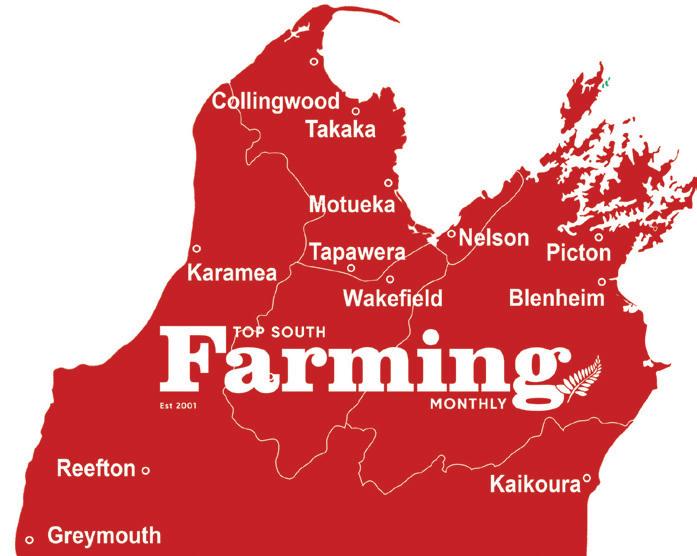
Tasman AG Ikamatua

Farmlands Westport
Karamea Visitor’s Centre
PGG Greymouth
Buller Vets
Farmlands Blenheim
Seddon Supermarket
Renwick Supervalue
Tractor Repairs & Spares Renwick
Farmlands Kaikoura
PGG Kaikoura
Rai Valley Brick Oven
4 Square Havelock
TSM Marlborough
A recent farmer confidence survey, taken by Federated Farmers, has tumbled to a new low.

From 1,103 responses from farm businesses nationwide, 65.2 per cent considered current economic conditions to be bad.

This is a 17.4 per cent rise in the number of farmers who believe the economy is in a worse condition than in July 2022 when the survey was last completed. The survey has been running since 2009 and these stats are a record low. Meat and wool farmers are the most pessimistic.
A net 81.8 per cent of farmer respondents expected economic conditions to deteriorate over the next 12 months, 0.9 points down from the survey six months ago.
Golden Bay Federated Farmers president, Cherrie Chubb. who is also a dairy farmer, is not surprised by the survey’s findings.

“It’s not just the short term political and compliance stuff, it’s bigger than that, Covid fatigued us, big weather events have taken such a toll and if you take a step back there has been a shift in farming over a long period of time and it’s all becoming a lot.”
Many local farmers are indicating that they feel they have absorbed a lot over the last five years and are wondering how far they can be pushed.
“Twenty-five years ago, farming was a system which rewarded entrepreneurial thinking and problem solving, good practical
people could make good gains by working hard but as things have evolved and the level of compliance puts real pressure on you, the whole ag sector has come under scrutiny,” Cherrie says.

For the first time ever Federated Farmers included asking questions around how farmers were coping mentally with the economic conditions.
An alarming 70.3 per cent of responders said that their mental health and well-being has been affected. Dairy farmers made up the biggest percentage of this.

“When your dealing with biological systems the variability farmers face day-to-day is really complex,” explains Cherrie. “Farmers are use to dealing with these complexities, however you are not going to get it right all the time,
most of us farmers do get it right most of the time but everyone has things here and there and when you are being judged and scrutinized that pressure builds up and it can then be hard to make the judgement calls that are needed to run a farming business.” When doubt affects farmers confidence it can mean less investment in farm improvements and production, and lower spending in the provinces. The survey registered a steep decline in profitability, with a net of 28.4 per cent of respondents reported making a profit currently which is down 26.7 points on the July 2022 survey. Looking ahead, 5.4 per cent of the respondents expect their production to decline over the year (4.9
per cent down on the July 2022 survey).
“It’s always a combination of things that get you down or overwhelm you, finances always impact and when you spend a lot of time in a state of uncertainty or stress it’s very draining”. Staff shortages throughout the industry also contribute to these statistics as those needing to have a reset break or circuit-breaker can’t find replacement staff to enable this which results in continued stress and tiredness. “When people get run down and tired it’s very easy for emotions to take over and the practical side of planning takes a back seat.” There is no doubt that costs are increasing and variables such as environment, staff, economics, climate, weather, and regulatory issues makes future planning harder.
Cherrie suggests that anyone who is feeling down or overwhelmed reaches out for
help “All this stuff isn’t yours alone. There are support services out there, not just personal help but experts that will help with farm systems and farm problems, there are some really good discussion groups around too.
“It also helps to network with others facing the same stuff, invite your neighbours over for a meal or drink, support each other by having a natter and clear your head, farming can be really isolating it can be hard to make the effort to get out an socialise but it’s one of the best ways to break the spiral of the blues and gloom.”
If you, or someone you know, needs help or support please contact:
• Rural Support Trust on 0800 787 254
• 1737 Free call or text 1737 any time, 24 hours a day to talk or text with a trained counsellor.
• Lifeline Phone 0800 543 354 or 09 522 2999 or text HELP (4357) any time
• Suicide Prevention Helpline 0508 828 865 (0508 TAUTOK0)
• Youthline 0800 376 633 or free text 234

• Samaritans 0800 726 666
• In an emergency call 111









